|

Jacob of Urhoy
(Urfa, in Turkey)
Testimonies of the brilliant historians of the Syrian Church of Antioch on
the Aramean origin of our nation, Synonymy: Aramean/Syrian.
 Subscribe
To Our Newsletter Subscribe
To Our Newsletter
Question:
Who were the ancient Assyrians? Were they simply one ethnicity or a
composition of many nations/ tribes?
Who made the East- Aramean Nestorians known as "Assyrians"?
SUA/WCA and allowing terrorism
Arameans of Syria.
Arameans of Turkey
Arameans of Iraq.
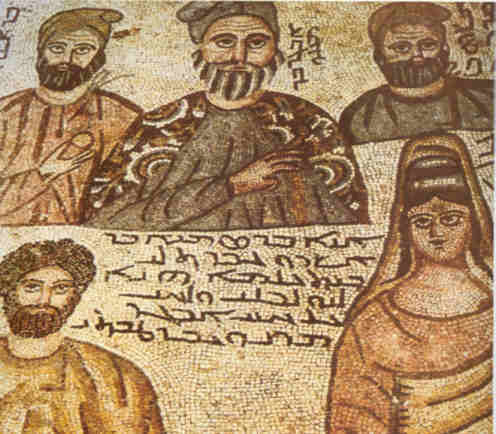
Aramean history, culture and language, a six partite interview
Colonialism, “Assyrianism” terrorism, occultism, downfall of the Aramean
nation in the Middle-East and their Diaspora.
26-6-2007:
Aram Nahrin: the Aramaeans, the Bible, Christianity, and the West
27-6-2007:
Aramaic: the Millennia Long Trajectory of the Global Language
28-6-2007:
Gabriel Sengo opens the Gates of Aramaean Thought, Culture and Wisdom
2-7-2007:
Do not Call the Illustrious Nation of Aramaeans by the Misnomer 'Assyrians'!
2-7-2007:
Extermination of the Aramaean Nation: Results of an Anglo – French Plan

(Photo:
wikipedia.org)
The
Historian Poseidonios from Apamea (ca.
135 BC - 51 BC), was a Greek Stoic philosopher, politician, astronomer,
geographer, historian, and teacher. He says: "
"The
people we Greek call Syrians, they call themselves
Arameans"
From: See
J.G. Kidd, Posidonius (Cambridge Classical Texts and Commentaries, 1988),
vol. 2, pt. 2, pp. 955-956)
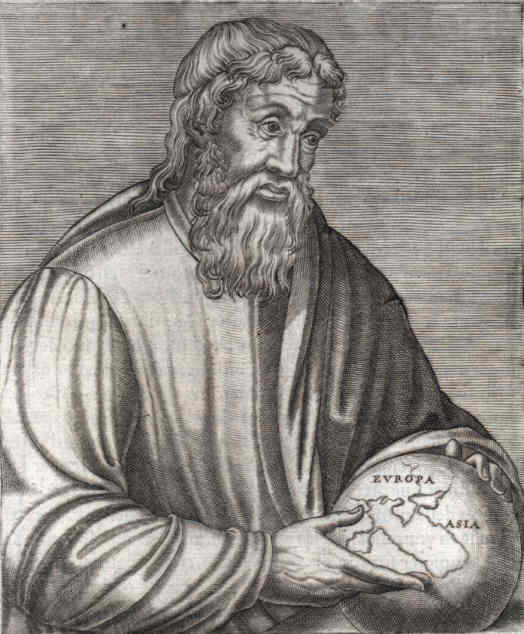
(Photo:
wikipedia.org)
Strabo (born 63 BC or 64
BC, died ca. 24 AD), a Greek historian, geographer and philosopher
is mostly famous for his Geographika ("Geography")
He says:
"Poseidonius conjectures that the names of these
nations also are akin; for, says he, the people whom we call
Syrians are by the Syrians themselves called
Arameans."
(From: The
Geography of Strabo, translated by Horace Leonard Jones and
published in Vol. I of the Loeb Classical Library edition, 1917,
Book I, Chapt. 2, 34)
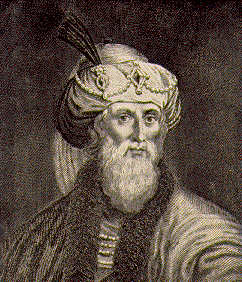
(Photo: http://www.ccel.org)
Flavius Josephus (c. 37 – c. 100 AD (or
CE)) was a 1st century Jewish historian and apologist of priestly and
royal ancestry who survived and recorded the Destruction of Jerusalem in 70
and later settled in Rome. He says: ""Aram
had the Arameans, which the Greeks called Syrians.""
(From:
Antiquities of the Jews, translated by William Whiston in 1737, Book I,
Chapt. 6)
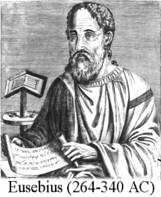
Eusebius of Caesarea (c. 275 – May 30,
339), was a bishop of Caesarea in Palestine and is often referred to as the
father of church history because of his work in recording the history of the
early Christian church. He says: ""and
from Aram the Arameans, which are also called
Syrians"
(From:
Sebastian Brock, "Eusebius and Syriac Christianity," in Harold W. Attridge
and Gohei Hata, eds., Eusebius, Christianity, and Judaism (Leiden 1992), p.
226)
Abu
Al-husayn 'ali Ibn Al-husayn Al-mas'udi, born 895 in Baghdad [Iraq] and died
957 in al- Fustat [Egypt], was a historian and traveler, known as "the
Herodotus of the Arabs.” He was the first Arab to combine history and
scientific geography in a large-scale work. On Tur Abdin he says:
"Tur
Abdin is the mountain
where remnants of the Aramean
Syrians still survive."
(From:
Michael
Jan de Goeje: Bibliotheca Geographorum Arabicorum III, Leiden 1906, 54, I)
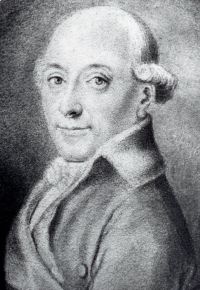
Prof. Dietrich Hermann Hegewisch born Dec.
15, 1746 in Quakenbrück [Germany] and died April 4, 1812 in Kiel, was a
prolific german historian at the University of Kiel with a wide span of
interests. He says: "Do
not the Syrians, as they are usually called, or the
Arameans, as they in fact are termed, deserve more attention in
world history than they are usually given?"
(From:
D.H. Hegewisch: Die Aramäer oder Syrer; ein kleiner Beitrag zur allgemeinen
Weltgeschichte, Berlinische Monatschrift, 2, 1794, p. 193)
On Page 197 he says:
"The names
Syria, Assyria, Mesopotamia, Babylon, etc. stem from the Greeks,
who were not familiar with the true geography
of these lands when the names first started to be used. Later, partly
because of continuing ignorance and partly because of
convenience despite having accurate knowledge, they persisted in
using them since it would have required something of an effort to give up
the old, familiar names and divisions of the countries and switch to the new
ones, even if they were more accurate. The old,
true, and single name of these lands is Aram; it is mentioned
numerous times in the Bible of the Old Testament, and Greek scholars were
also familiar with it and probably described the population of these areas
as Arameans, though seldom, as they usually continued
to use the term Syrian, which had been familiar to the Greeks."
On page 307 he says:
"The Syrians or Arameans were not merely
a numerous and large people, they were also a
much cultivated people."

(Photo: http://portrait.kaar.at)
Prof. Theodor Mommsen born Nov. 30, 1817,
Garding, Schleswig [now in Germany] died Nov. 1, 1903, Charlottenburg, near
Berlin, was a German historian and writer, famous for his masterpiece about
the History of Rome. He received the Nobel Prize in Literature in 1902. He
says:
"the history of the Aramaean or Syrian nation
which occupied the east coast and extended into the interior of Asia as far
as the Euphrates and Tigris"
(From: The
History of Rome, written between 1854 and 1856, Leipzig, by Theodor Mommsen,
Book First, Chapter One)
"the Arameans defended their nationality with the
weapons of intellect as well as with their blood against
all the allurements of Greek civilization
and all the coercive measures of eastern and
western despots, and that with an obstinacy which no Indo-
Germanic people has ever equalled, and which to us who are Occidentals seems
to be sometimes more, sometimes less, than human."
(ibid,
Book Third, Chapter One)
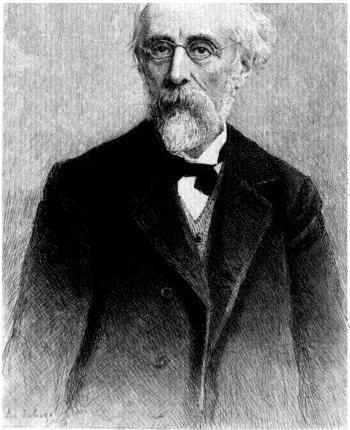
(Photo:
wikipedia.org)
Prof. Theodor Nöldeke born March 2, 1836 in
Harburg near Hamburg, died December 25, 1930 in Karlsruhe, was the leading
german semitic scholar, who studied at Göttingen, Vienna, Leiden and Berlin.
He says:
"The main body of the population of all these wide landscapes from the
Mediterranean Sea to beyond the Tigris belonged to
a certain nationality, that of the Arameans."
(From: Th.
Nöldeke: Assyrios Syrios Syros, in Zeitschrift für klassische Philologie,
Hermes 5, Berlin 1871, p. 460)
On page 461 he says:
"It is well understandable that people have started to transfer the name of
the country to the most important nationality and so
the name 'syrian' was apprehended ethnological and was equated with 'aramaic'."
On page 468 he says:
"Since the times of Alexander [the Great], if not already somewhat earlier,
people have started to transfer the name of the
Syrians exclusively over the prevailing in Syria nationality, and in
this way this originally political-geographical term became an
ethnological one that was identified with the local
Arameans."
"From the time the Greeks came to have a more intimate acquaintance with
Asia, they designated by the name of Syrians, the
people who called themselves ´Arameans’.”
(From: Th. Nöldeke, Kurzgefasste Syrische Grammatik (Leipzig, 1880), p.
XXIX)
"Regarding
the name of this nation and its language is the original 'Aramean’
in essence also the only one [sic], that for the employment of the
present-day scholarship as yet strongly fits.”
(From: Th. Nöldeke, "Die Namen der aramäischen Nation und Sprache,” in
Zeitschrift der Deutschen Morgenländischen Gesellschaft 25 (1871), p. 131)
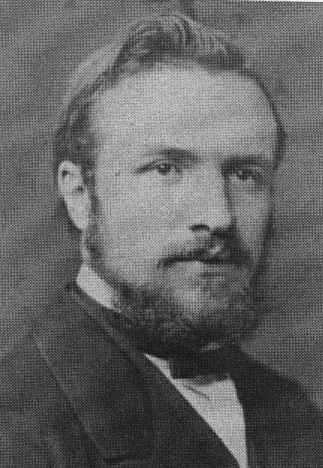
(Photo:
www.doaks.org)
Karl Eduard Sachau born 20 July 1845 and
died 1930 was a German orientalist. He was 1872 professor at the University
of Vienna, and in 1876, professor at the University of Berlin, where he was
appointed director of the new Seminar of Oriental languages in 1887. He is
especially noteworthy for his work on Syriac and other Aramaic dialects. He
says:
"The nation of the Arameans: This
national name later, mainly in consequence of Jewish-Christian literature
influences, gave way to the Greek designation
Syrians."
(From:
Verzeichnis der Syrischen Handschriften der königlichen Bibliothek zu Berlin
von Eduard Sachau 1. Abteilung, Berlin 1899, Vorrede I)
|
Aramean people:
Aramean people (not to be confused with ‘Armenians’) speak Aramaic, the
language spoken by Abraham, Moses and Jesus. They are the indigenous people
of what was called
in ancient times Aram- Nahrin, in our days it is called ‘Mesopotamia’.
Some Arameans today
identify themselves with “Assyrians”,
because of the spiritual colonial hate generating activities of the Western
missionaries and diplomats in the Middle-East in 16th and 19th
centuries. Other Arameans became known as “Chaldeans”. However all of them
are Arameans.In
Turkey, the Arameans are called: Süryani. In Arabic they are called Al-
Suryan.
Testimonies of the scholars of the Syrian
Church of Antioch on the
synonymy: Aramean/Syrian
(Please be informed that in our days the nationalistic/fanatics,
the
colonial illuminati product "Assyrians", try by all means
possible to distort our rich heritage by stating that the word “Syrian” is
abbreviation of “Assyrian” and hence they label all the Aramean denominations
wrongfully and in contradiction to the historical facts as “Assyrians”.
Please
take note of the testimonies of the brilliant historians of the Syrian Church of
Antioch (Both West and East-Syrian) who testify regarding the Aramean origin of
the Syrian people. If some of so-called the Western "scientists" studied in the past the works of
these historians- who had access to the original sources-, they most likely would not have invented mythical terms like
“Assyrians” and “Chaldeans” to split our nation!)
Dutch Version
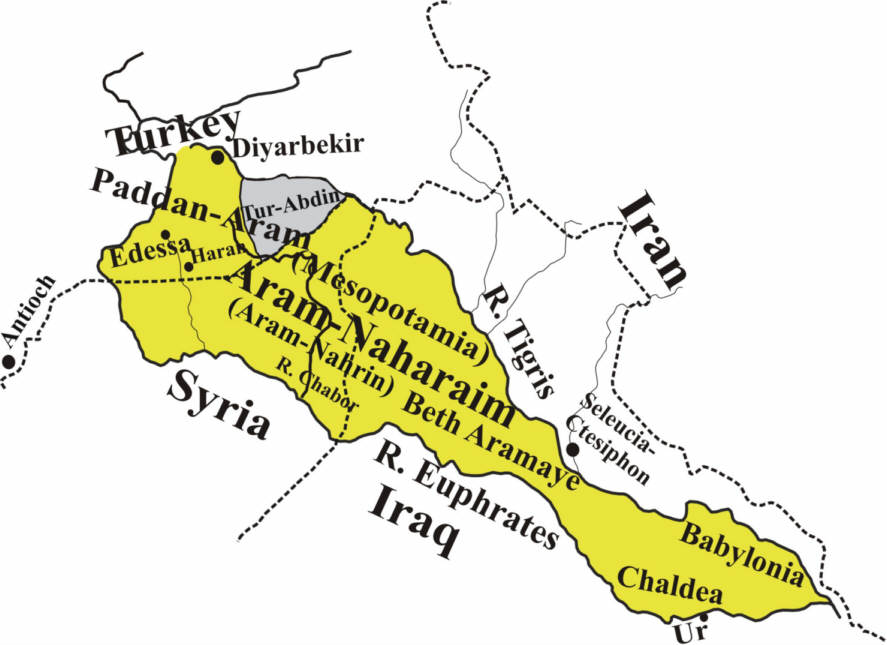 |
The area where the Aramean people come from was
known as “Mesopotamia” and has been divided into the modern
countries Iraq, Syria, and Turkey since the 20th century.
In the ancient times the cradle of the Aramean
forefathers was called Aramnahrin (or: Aram-Nahrin) in Aramaic. In
Hebrew it was called Aram-Naharaim which we encounter in the Old
Testament. When the Old Testament was translated into Greek, the
term Aram-Naharaim was translated into Mesopotamia, which many
become familiarized with through reading many educational and
historical texts. |
Roughly speaking, this area is situated in present
south-eastern Turkey/northeren Syria.
The northern area of Aram-Naharaim was called Paddan-Aram, meaning
the land of Aram where Biblical figures like Abraham and Jacob lived and
walked. A section of Paddan-Aram is now called Tur Abdin in
the Aramaic (Syriac) language, which means “the mountains of the servants of
the Lord”, due to the overwhelming presence of monasteries and churches.
According to the Aramean historical traditions, the area
of Paddan-Aram- in particular ‘Tur Abdin’ – is the proto-land of the Aramean
nation. From this proto- or indigenous land, in the course of time, the
Arameans started to expand all over the near east.
Because of overwhelming presence of Arameans in the southern part of Aram-Nahrin,
in the era of early Christianity, it was called Beth-Aramaye, meaning (in
Aramaic) “the house of Arameans”
Aramean people and Christianity
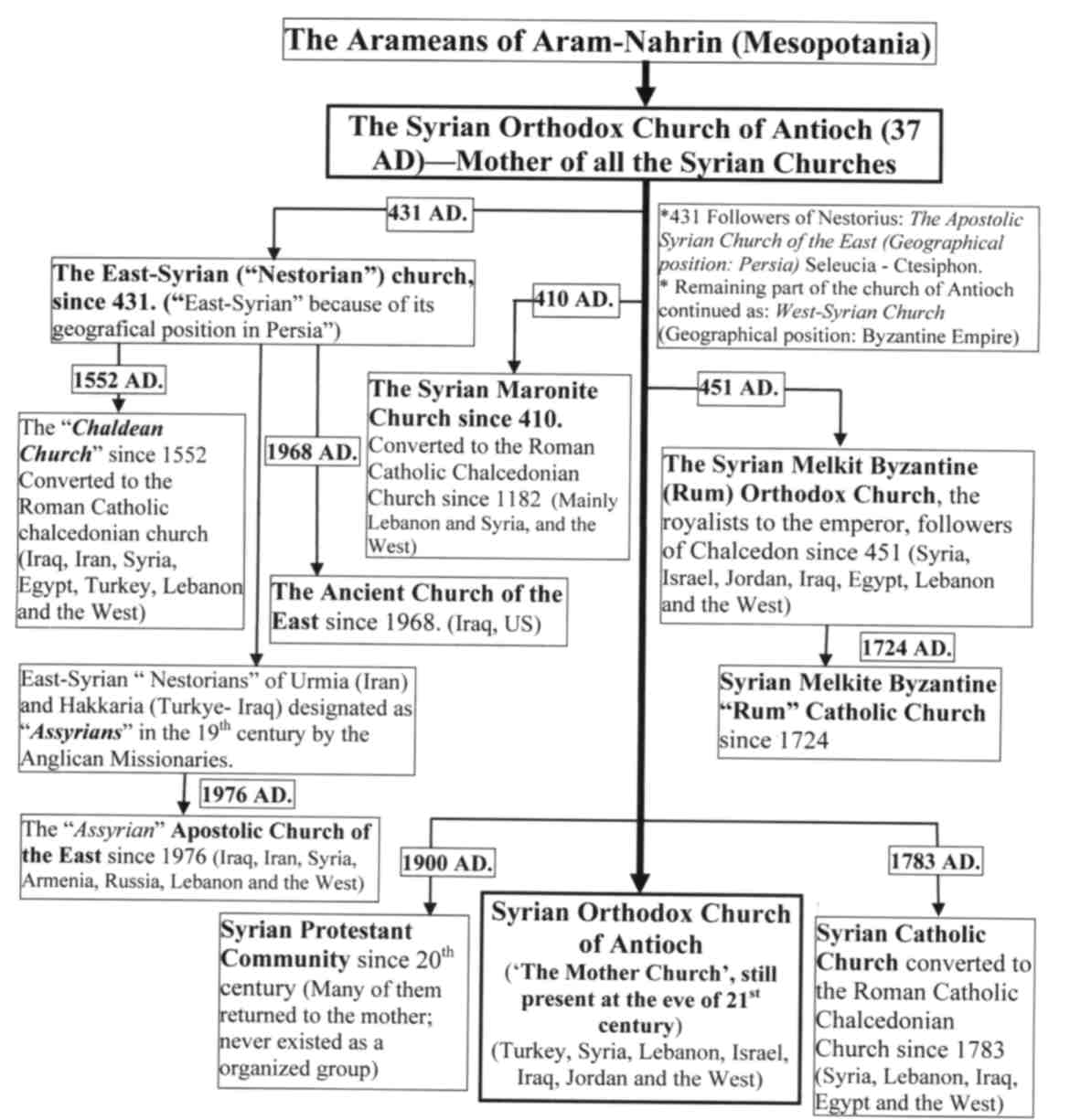
After the coming of Jesus Christ, the Arameans (including
Assyrians and Chaldeans) of Aram-Naharaim accepted the teachings of Christ
and established together with the apostles of Yesuh M'siho and the converted Jews,
the Syrian Church of Antioch, the second Patriarchy after Jerusalem, where
for the first time the followers of Yesuh M'siho were called Christians
(Acts 11:26). This church was the mother of all the Churches and the first
Church established outside Israel, whose Patriarch currently resides in
Damascus, Syria.
The Semitic Arameans (‘not to be confused with
“Armenians”) underwent a change of name after they had embraced Christianity
and were then called “Syrians” for unknown reasons. Some say to distinguish
from the Arameans who were not converted to Christianity, while others say
that when the Greek Empire expanded into the region, they called them “Syrians”,
because the Greeks were not familiar with Arameans.
This might be true, because
the Greek historian Posidonius (150
BC) says,, “ The
people we (Greeks) call Syrians, were called by the Syrians self Arameans….
for the people in Syria are the Arameans “.
This is repeated by Strabo (Greek historian, born ca. 63 BC), the Jewish
historian Flavius Josephus (first century AD) and others who all have
testified to the fact that the people, whom the Greeks called Syrians,
called itself Arameans
And this is also reflected in the translation of the Old
Testament from Hebrew to Greek.
The Old Testament was translated in
third century BC. This translation was called the Septuagint (abbreviate
form “LXX”). In the Septuagint the terms “Aram”,
“Arameans”, “Aramaic”,
and “Aram-Naharaïm”
were translated with the words "Syria”,
“Syrians”, “Syriac”, and “Mesopotamia.”
The Authorized King James Version -1611 is following the same
path
and calls the Arameans in both the Old and New Testament “Syrians.”
The Arameans of
the Old Testament are called “Syrians” in the New Testament.
In other Bible translations however, the Arameans of the
Old Testament are called “Syrians” in the New Testament.
In Luke 4:27 Jesus Christ mentions the healing of Naaman
the Aramean by Prophet Elisha (2 Kings 5:1-15) and says:
“And there were many in Israel with leprosy in the time of
Elisha the prophet, yet not one of them was cleansed—only
Naaman the Syrian”
The designation “Syrian” should not be confused with the
present-day Arameans of Syria who identify themselves as “Arabs”, following
the wicked colonial activities of France and United Kingdom.
In deeper sense however, the name "Syrian" belongs to the
Aramean nation and not to the “Arabs” invaders. However, after the conquer
of Mesopotamia by “Arabs”, they adapted the name "Syrian"; with the result
that the real Syrians, that is to say: Arameans; became strangers in their
own indigenous lands.
East-/West-
Arameans River the Euphrates
The Arameans were spread throughout Middle-East
and were termed as East- and West- Arameans. This has to do with the
geography at the beginning of Christianity. Roughly speaking, river the
Euphrates was de border. The Arameans living Eastern of Euphrates, the
Persian Empire, were called “East- Arameans” or “East- Syrians”; thus
Nestorians who later became known as “Chaldeans” (1552) and again later as
“Assyrians” (19th century).
The Arameans living Western of Euphrates, the Roman/Byzantine Empire, were called
“West- Arameans” or “West- Syrians” or in short just “Syrians”. And
sometimes both the East- as well as the West- Arameans are called “Syrians”;
if not specifically indicated!
The Church in the Roman Empire: Syrian orthodox church of
Antioch; the mother Church; with Antioch as the Ecclesial Jurisdiction.
The Church in Persia: The Church of the East or
the Church of Persia, Seleucia Ctesiphon as the seat of the Catholicos. However
the Arameans in Persia were still under the jurisdiction of Antioch until
424 Ad.
Non-Christian
Arameans
The Arameans who did not convert to Christianity,
remained heathens; however with the advent of Islam many of them converted/
forced
to Islam, forgot their Aramean origin, and hence were called "Arabs."
Other Arameans who in the course of the time were also forced to the Islam
became known as “Kurds” and “Turks.”
There are in Syria
two villages called Jubb ‘Addin and Bakh’a (50 km from
Damascus) where the inhabitants are Moslems. These Moslems speak Aramaic and
are aware of their Aramean origin. They are so proud of their Aramean origin
that they even translate songs from other languages into Aramaic and
maintain their customs and traditions. However, other Arameans who converted
to Islam and did not maintain their Aramaic language, adopted Arabic and
hence are called in our days "Arabs". These "Arabs" are not Arabs in the
sense of their ethnicity, but rather because they have adapted Arabic. Thus
they are linguistically "Arabised", not ethnically!
At the time of Mohammed, Arabs were negligible tiny
minority compared to the overwhelming Aramean presence in the Middle-East.
“…..all
the Arab population at the times of Prophet Muhammad did not outnumber the
inhabitants of just one Aramaean city like Damascus, Nisibis, Ctesiphon,
Dura Europos, Palmyra, Homs, or Edessa”
(The Aramaeans' rise
will transfigure the Middle Eastern Chessboard)
In short: There are
millions of Islmaic Crypto-Arameans in the Middel-East who go by the names
"Arabs", "Kurds"
or "Turks."
Please click
here,
here
and
here for more on the non-Christian Arameans of Middle-East
Synonymy: Aramean/Syrian
Below, we present you the testimonies of scholars of
all the Aramean denomination regarding their awareness of their Aramean
origin.
|
The brilliant scholars of the Syrian church of Antioch regarding the
origin of our people |
شهادات علماء للكنيسة السرينية الأنطاكية بخصوص أصل شعبنا السرياني
الآرامي |
Content
|
 Scholars
of West-Syrian Church Scholars
of West-Syrian Church
1.
St. Afrem the Syrian (†
373)
the Harp of the Holy Spirit,
2.
The learned Saint James of Sarug (Sürüç, Turkey,
†512)
3.
John of Beth Rufina, priest at Antioch and disciple of the great
anti-Chalcedonian leader, Peter the Iberian (417-491),
4.
The 6th century historian and Bishop Simeon of Beth Arsham, which
was located near Seleucia-Ctesiphon,
5.
Patriarch Severius of Antioch, also known as de
Crown of Syrians (†538, Egypt)
6.
Saint Jacob of Edessa
(present-day Urfa in Turkey, †708)
7.
The Anonymous of Zuqnin, near Amid [Turkey]
writes in his Syriac world-chronicle of c. AD 775 regarding the year
504-505
8.
Monk Anton of Tikrit (Iraq, †
840-850) on Wafa the Aramean
9.
Moses Bar Kepha (Bar Keepho), a celebrated bishop and writer
10.
Dionoysius Bar Salibi the Syrian-Orthodox bishop of Amid (Diyarbekir,
Turkey, †1171),
also called the star from the 12th century
11.
The Syrian-Orthodox Patriarch St. Michael the Great of Militene
(Malatya, Turkey, †
1199 AD) says about the children of Shem
12.
The well known Syrian-Orthodox Maphrian and scholar Bar Hebreaus
from Militene (Malatya, Turkey, †1286),
by the modern scientist called the library from the 13th
13.
The Great Metropolitan Philoxenos Yuhanun
Dolabani (1885-1969), born in Mardin [Turkey], was one of the
outstanding scholars
======================West-Araamean Syrian
Catholic Church=================
14.
Clemens Joseph David, born 1829 in Amadiye [Iraq] and passed away in
the year 1890, was ordained Archbishop of Damascus in 1879.
15.
Ishak Bar Armalto, born 1879 in Mardin [Turkey]
and passed away in 1954 in Beirut [Lebanon],
======================West-Araamean Syrian
Maronite Church=================
16.
Paul Assemani (1878-1944) was from the
famous Maronite family Assemani
17.
Paul Al-Khoury Al-Kfarnissy (1888-1963) was
professor of Syriac at the Lebanese Maronite Order
======================West-Araamean Syrian
Melkite Church=================
18.
Agapius of Hierapolis/Mabbug [Iraq] was a 10th century bishop |
|
 Scholars
of East-Syrian Church Scholars
of East-Syrian Church
1.
Simon Bar Sabbae (?
344), was bishop and the second Catholicos of Seleucia-Ctesiphon
2.
In the Chronicle of Arbela[2], considered to be from 6th
century,
3.
Severus Sebokht, born in 575 in Nisibis and passed away in 666/67,
4.
The Chronicle of Khuzistan (Iran), is written by an Aramean
Christian from Khuzistan
5.
Garden of Delights ("Gannath Bussame") written around the 8th/9th
century
6.
The author of the chronicle of Se’ert
7.
Catholicos-Patriarch Timotheos I of the Syrian (“Nestorian”) Church
of the East
8.
Isho Barnun (?
827) [8], who was taught by Mar Abraham bar Dashandad
9.
Theodor Bar Koni, (?
845 in Syria),
10.
Isho'dad was a native of Merv (Turkmenistan).
11.
Thomas of Marga, born early in the 9th century in the region of
Salakh (Mosul)
12.
The East-Syrian “Nestorian” lexicographer Isho Bar Alii (?
890)
13.
East-Syrian "Nestorian" writer and bishop Yeshudad from Haditha (?
853)
14.
The East-Syrian "Nestorian" lexicographer Bar Bahlul from Bagdad (?963)
15.
Catholicos- Patriarch Elias I of Tirhan (1028-1049) also called
Elias of Nisibis
16.
The theory of Galileo Galilei, the astronomer, was treated by a
bishop of Urhoy in the 10th century
17.
The East- Syrian “Nestorian” bisschop Solomon from Basra says in his
book
====================East-Syrian Chaldean church of
Babylon==================
18.
The East- Syrian Chaldean Patriarch Joseph (1681-1695)
19.
Mor Touma Audo, born in Alqosh [Iraq] in 1855
20.
Gevargis Abd- Ischo V, Patriarch of Babylon (1894-1899)
21.
Metropolitan Aday Sher, born 1867 in Shaqlawa [Iraq]
22.
Ya‘qob Avgin (= Eugene) Manna (1867-1928) born in Beth Qopa [Iraq]
23.
Bishop Israel Audo, born 6 Aug 1859 in Alqosh [Iraq] a
|
|
The brilliant scholars of the Syrian Church of Antioch |
العلماء اللامعين للكنيسة السريانية في أنطاكية |
|
The scholars of the
West-Syrian Church
The Syrian Orthodox Church of Antioch
The Syrian Catholic Church
Syrian Maronite Church
Syrian Melkite Church |
علماء الكنيسة السريانية الغربية
الكنيسة السريانية الأرثوذكسية في أنطاكية
الكنيسة السريانية الكاثوليكية
الكنيسة السريانية المارونية
الكنيسة السريانية الملكية |
|
1.
St. Afrem the Syrian (†
373)
the Harp of the Holy Spirit,
the famous Church father of the Syrian Church of Antioch, names the
famous Bar Dayson (154-
222 A.D)
of Edessa “Bar Dayson the
Aramean Philosopher”[1]
|
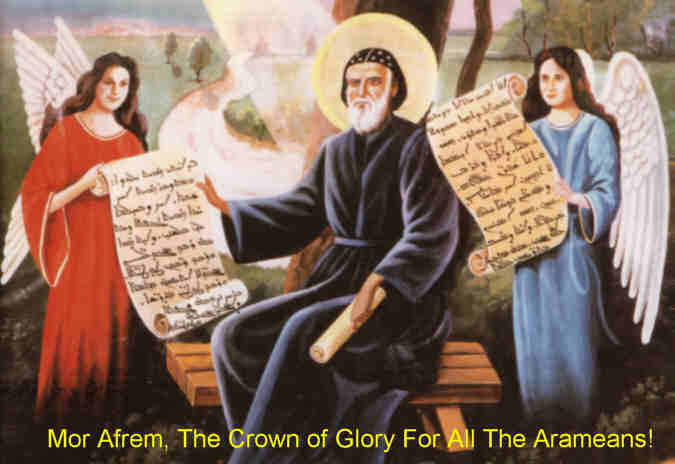
St.
Afrem, the Aramean, the Crown of Glory For All The Arameans |
1. مار أفرام السرياني (373†)،
وهو قيثارة الروح القدس ، والأب الشهير
للكنيسة السريانية الأنطاكية، وهو
يذكرعن بار ديسون الشهير (154-222
م.) " بار ديسون الفيلسوف الآرامي" |
|
1.1
He
speaks of Aram-Nahrin (= Mesopotamia) as `our country'
in a number of places[1.1] |
1.1.
انه يتحدث عن آرام بين النهرين (= بلاد ما بين النهرين) "بلدنا"
في أماكن مختلفة[1.1] |
|
1.2
In his discourse composed against the famous philosopher Bardaisan
from Edessa (Urfa) he writes [1.2]: |
1.2
في خطابه ضد الفيلسوف الشهير
بارديسون من الرهاEdessa
(Urfa)
يكتب[1.2]: |
|
1.2.1.
"But the philosopher of the Arameans made himself a
laughing-stock among Arameans and Greeks" |
1.2.1.
"أضاف "لكن الفيلسوف الآرامي جعل نفسه عرضة للسخرية بين
الآراميّين واليونانيين. |
|
1.2.2.
"Because 'light' in Aramaic language is called as masculine, and
'eye' feminine in the same" |
1.2.2.
"لأن يُعتبر'الضوء' في اللغة الآرامية مذكر، و'العين' مؤنث |
|
1.2.3.
"He, Bardaisan, calls the moon feminine in the Aramaic language
|
1.2.3.
وهو،( بارديسون)، دعا القمر مؤنّث في اللغة الآرامية" |
|
1.3
In another discourse against Mani he says:
"and there ended the construction of the Aramaean Philosopher"[1.3] |
1.3 في آخر خطابه ضد ماني يقول:"..
وأنه هناك إنتهى بناء الفيلسوف الآرامي "[1.3] |
|
1.4
Regarding Jesus and the healing of the Canaanite
woman's daughter he says in his appeal to the Lord [1.4]:
"Doctor who in his mercy healed the girl which is
the daughter
of the Arameans, heal our souls." |
1.4 عن يسوع المسيح وشفاء إبنة المرأة الكنعانية يقول في طلبته
إلى الرب [1.4]:
الطبيب الذي برحمته شفا الفتاة
التي كانت إبنة الآراميين؛ إشفِ نفوسنا" |
|
2.
The learned Saint James of Sarug
(Sürüç, Turkey,
†512)
describes Saint Ephrem the Syrian (†
373) in a hymn as honor to the Aramean nation opposing the Greeks
and states[2]:
 "This (Efrem) who became
a crown of glory for all the Arameans,
and through him they became near the spiritual splendors. He who
became a great orator among the Syrians." "This (Efrem) who became
a crown of glory for all the Arameans,
and through him they became near the spiritual splendors. He who
became a great orator among the Syrians."
 “He
who raised up the horn of the Syrians everywhere,
(and) from him henceforth we have learnt to sing to the Lord with
sweet songs" “He
who raised up the horn of the Syrians everywhere,
(and) from him henceforth we have learnt to sing to the Lord with
sweet songs" |

West-Aramean Syrian Orthodox Jacob of
Sarug |
2. العالم مار يعقوب السروجي (سروج، تركيا،512†)
يصِف مار أفرام السرياني
(†
373)
في ترنيمة لتبجيل الأمة الآرامية، ويعارض فيها الأمة اليونانية
ويقول[2]:
 هذا (أفرام) أصبح تاج العظمة لجميع الآراميين ومن خلاله إقتربوا
من العظمة الروحية. وكان خطيب كبير بين السريان".
هذا (أفرام) أصبح تاج العظمة لجميع الآراميين ومن خلاله إقتربوا
من العظمة الروحية. وكان خطيب كبير بين السريان".
 "الذي رفع شأن (قرن) السريان في كل مكان
"الذي رفع شأن (قرن) السريان في كل مكان
ونحن منذ ذلك الوقت تعلمنا منه أن نرتل للرب التراتيل الحلوة
والهتافات". |
 "He
who gazed diligently in his mind on the great Moses, and after the
model of the Hebrew women he taught the Aramaean women to
give praise with their madrashe" "He
who gazed diligently in his mind on the great Moses, and after the
model of the Hebrew women he taught the Aramaean women to
give praise with their madrashe" |
 وبذهنه الحاذق تأمل في موسى العظيم وفي نموذج النساءالعبريات وكذلك
علّم نساء الآراميين
لكي يسبّحن الله في ترانيمهنّ".
وبذهنه الحاذق تأمل في موسى العظيم وفي نموذج النساءالعبريات وكذلك
علّم نساء الآراميين
لكي يسبّحن الله في ترانيمهنّ". |
|
2.1
In his Homily on Aday and King Abgar he writes [2.1]: |
2.1
في عظته عن آداي والملك أبجر يكتب[2.1]: |
|
2.1.1
"[The Patriarch] Jacob and [the apostle] Aday were sent to
Aram-Nahrin, so that they would fulfill both the New and Old
(Testament words)." |
2.1.1
"[ البطريرك] يعقوب و [الرسول] آداي أرسِلوا إلى آرام ما بين
النهرين، وفاءً لتنفيذ كلمات العهد الجديد والقديم"
|
|
2.1.2
"Aday himself, too, came to the land of Beth-Oromoye,
so that
these symbols drawn by Jacob would be fulfilled through him. And
(so) in Urhoy he opened up a big fountain of living waters." |
2.1.2
"آداي نفسه أيضا جاء إلى بلاد ما بين النهرين،
لكي تتحقق الرموز التي
رسمها يعقوب من خلاله.
وبالتالي فتح في الرها (أورهوي) ينبوع كبير من المياه الحية" |
|
2.2
In his Homily on
Urhoy and Jerusalem:
"The darkness of the world and the blackness of Abgar, the
Aramaean's son, the world of darkness became light through Abgar
in Christ."[2.2] |
2.2
"في عظته عن الرها وأورشليم يقول: ظلام العالم وسواد أبجر (Abgar)،
إبن الآراميين
، عالم الظلام أصبح ضوء من خلال أبجر في المسيح." [2.2] |
|
2.3
About Edessa (SanliUrfa) he says[2.3]:
"The daughter of the Arameans, albeit aloof, heard his lore" |
2.3 عن الرها (
Edessa
/(SanliUrfa
يقول
[2.3]:
"إبنة
من السريان الآراميين،
رغم أنها كانت مترددة، استمعت تعاليمه". |
|
2.4
In
the Homily on “Guria and Shamuna” the martyrs from the neighborhood
of Edessa (Urfa) and says[2.4]: "Two precious pearls,
which were an ornament for the bride of my lord Abgar, the
Aramaean's son. |
2.4 في عظة عن "جوريا وشامونة" (Guria
en Shamuna)
الشهيدتين من أطراف الرها يقول[2.4]: اللؤلؤتين الثمينتين اللتين
كانتا زينة لعروس سيدي أبجر، إبن الآراميين".. |
|
3.
John of Beth Rufina, priest at Antioch and disciple of the great
anti-Chalcedonian leader, Peter the Iberian (417-491), writes about
the Life of St. Abhai, bishop of Nicea[4] : |
3. يوحنا من بيت روفينة،
قس في
أنطاكية وتلميذ بيتر ايبيريا الزعيم الكبير المضاد
لخلقيدون (417- 491Petrus
de Iberian)
يكتب عن حياة القديس أبهاي (Abhai)،
أسقف نيقيا (Nicea)[4]: |
|
3.1.
"In both scholastics they were educated; in Aramaic, which is Syriac
and in Greek, which is called roman." |
3.1
"وفي
كلتا المدرستين كانوا متعلمين، في الآرامية ، التي هي السريانية
وفي اليونانية
وهي ما تسمى الرومانية
|
|
3.2.
"In that time they learned to proceed the sciences in this
scholastic Aramaic, that is to say Syriac." |
3.2
في ذلك الوقت كانوا يدرسون لكي يطورون العلوم
في هذه اللغة الآرامية المدرسية، أي السريانية". |
|
3.3.
"After the flood in the days of Noah, the Arameans inhabited Beth
Nahrin." |
3.3
"
بعد الطوفان في أيام نوح ، الآراميون سكنوا بلاد ما بين النهرين". |
|
3.4.
"Many of the children of Aram
were educated in the
Greek language." |
3.4
وكثير من أبناء آرام كانوا يتعلمون في اللغة اليونانية |
|
4.
The 6th century historian and Bishop Simeon of Beth Arsham,
which
was located near Seleucia-Ctesiphon, was a famous man who made
disciples and baptized three great and famous men among the Magians,
says in a letter concerning Barsauma and the heresies of the
Nestorians [5]: |
4. مؤرّخ القرن السادس المطران سمعان من بيت أرشام، التي تقع بالقرب
من سلوقية-كتسيفون، وكان رجلا شهيراً وهو الذي تلمذ وعمّذ ثلاثة رجالا
كبارا ومشهورين من رجال مجيينس (Magians)
ويقول في رسالة بشأن
برصومو
وبدع النسطوريين [5]: |
|
4.1.
"In the days of Catholicos Babai heresies of the disciples of Paul
from Samosata and Diodor from Tarsus emerged in the country of
Beth Oromoye" |
4.1
" في أيام المفريان (الكاثوليكوس) باباي
ظهرت في البلاد
بيت أورومويى
بُدع تلاميذ بولس من سموساتا وديودوروس من ترسوس" |
|
4.2.
About Mor Benjamin, he says “Mar
Benjamin the Aramean,
who later became the abbot of the school in the village of Daira,
which (lies) in the diocese of our monasteries." |
4.2
عن مار بنيامين يقول: "مار بنيامين الآرامي، الذي أصبح فيما
بعد رئيسا لمدرسة القرية الدائرة، التي تقع في أبرشية ديرنا" |
|
5.
Patriarch Severius of Antioch, also known as de Crown of Syrians (†538,
Egypt) says in one of his writings [6] “"It is in this
same way also we the Arameans, that is to say the Syrians…"
|
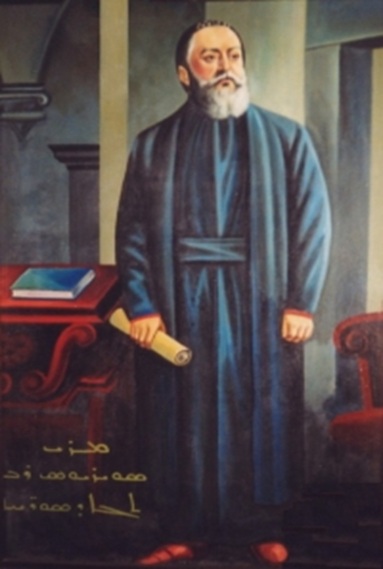
West-Aramean
Syrian Orthodox Patriarch Saverios of Antioch |
5. البطريرك سيوريوس الأنطاكي، المعروف أيضا بإسم تاج السريان (538† ،
مصر) يقول في واحدة من
كتاباته[6]:
وهذا هو أيضا المقصود، عندما نقول نحن الآراميون نعني نحن
السريان"...
|
|
6.
Saint Jacob of
Edessa
(present-day Urfa
in Turkey,
†708)
says about
the Syriac language he writes in his book "The Six Days"
[6.1]:
 "The
Syriac language, that is Aramaic" "The
Syriac language, that is Aramaic"
 "It
appears that the south was so named also by us Arameans. But
as for the north, it is not known to us why it was called (such)
by the ancient sons of Aram." "It
appears that the south was so named also by us Arameans. But
as for the north, it is not known to us why it was called (such)
by the ancient sons of Aram."
 "But
in the manner of speaking (of) the Arameans, (some) people
call them chirping gadflies." "But
in the manner of speaking (of) the Arameans, (some) people
call them chirping gadflies." |

West-Aramean Syrian Orthodox Jacob
of Edessa/Urhoy, Urfa |
6.
مار يعقوب الرهاوي (تركيا، أورفة،
†
708)
يقول عن اللغة السريانية في كتابه " الأيّام الستة" [6.1]:
 اللغة السريانية, أي اللغة الآرامية".
اللغة السريانية, أي اللغة الآرامية".
 ويبدو أن الجنوب كان يدعى من خلالنا نحن الآراميون
ولكن بخصوص الشمال،
ليس معروفا لنا لماذا أطلق عليه أبناء آرام الأولين (هذا) الإسم ".
ويبدو أن الجنوب كان يدعى من خلالنا نحن الآراميون
ولكن بخصوص الشمال،
ليس معروفا لنا لماذا أطلق عليه أبناء آرام الأولين (هذا) الإسم ".
 " ولكن بعض الناس يُشبِّهون طريقة حديث السريان، بغناء ذبابة
الحصان"
" ولكن بعض الناس يُشبِّهون طريقة حديث السريان، بغناء ذبابة
الحصان" |
|
7.
The Anonymous of Zuqnin, near Amid [Turkey] writes in his Syriac
world-chronicle of c. AD 775 regarding the year 504-505[7]:
"The year eight hundred and sixteen: The Romans devastated all
the Persian territory from Nisibis to the
boundaries of Beth
Aramaye, killing, destroying, taking prisoner and plundering." |
7. كاتب من زوقنين (مجهول الإسم) ، بقرب أوميد [تركيا] يكتب في تقريره
(وقائع العالم) بالسرياني من نحو 775 ميلادية عن السنة 504-505 [7]:
"عام
ثمانمائة وستة عشر : الرومان دمروا جميع الأراضي الفارسية من
نصيبين
إلى
حدود
بيت آرامايى،
بالقتل والتدمير والسلب والنهب والسجن" |
|
7.1
About the imposator appeared in the West and seduced and killed many
among the Jews he says[7.1]: "He went down to the land
of Beth Aramaye that was immersed in all the evils of
sorcery, and devoted himself to sorcery and all diabolical tricks." |
7.1
عن مخادع ظهر في الغرب
،أغوى وقتل العديد من اليهود يقول[7.1]:
ذهب إلى داخل أرض بيت آرامايى، التي كانت مملوءة من جميع شرور
السحر، وكرّس نفسه للسحر والحيل
الشيطانية
" |
|
7.2
In relation to Jazira, the term which refers to Upper Mesopotamia
from Osrhoene in the West to Mount Sinjar in the East, being the
land of the Syriac-speaking Christians we read [7.2]:
"land which spoke the language of the children of Aram" |
7.2
وفيما يتعلق بالجزيرة ، هذا المصطلح الذي يشيرإلى أعالي بلاد ما بين
النهرين من أوسرون غرباً حتى جبل سنجار شرقاً، أرض المسيحيين
الناطقين باللغة السريانية، نقرأ [7.2]: أي
الأرض التي تتكلم لغة أبناء آرام
|
|
7.3
About the Arab Muslims who married Christian women we read[7.3]:
"As for the people who married (Syrian) women, sired Syrian
children, and mixed with the Syrians, and whom no one
was able to
distinguish from the Aramaeans, he quickly found out about
them." |
7.3
عن العرب المسلمون الذين كانوا يتزوجون نساء المسيحيين نقرأ[7.3]: أما
بالنسبة للشعب الذي تزوج بالنساء السريانيات، وَلدواأطفالاً إنخلطوا مع
السريان وليس
أحداً إستطاع أن يميِّزهم من الآراميين،
إنه سريعا اكتشف عنهم". |
|
8.
Monk Anton of Tikrit
(Iraq,
†
840-850) on Wafa the Aramean[8]: “The fifth meter of
poetry is usually composed of six or seven strophics whose number
sometimes increases or decreases. This meter belongs to man named
Wafa, an Aramean philosopher.” |
8. الراهب أنطون من تكريت (العراق،†
840-850)
يقول عن وفاء الآرامي[8]:"
الوزن الخامس من الشعر عادة يتألف من ستة او سبعة آيات، الذي عدده
أحيانا يكون الزيادة أو النقصان وهذا الوزن يَعود إلى رجل يدعى
الفيلسوف وفاء الآرامي".
|
|
9.
Moses Bar Kepha (Bar Keepho), a celebrated bishop and writer, born
at Balad (near Tigris) in 813 and passed away in 903, says in his
book "The Six Days" [9]: ”Mor Philoxinos said also
that the translation of the Bible is called ”The Easy (Peshitta)",
which was translated into our Aramean language by Agolas and
Soomkhos.” |
9.
موسى ابن كيفا (بر كيفو)، الأسقف والكاتب ، ولد في مدينة بلد (بالقرب
من نهر دجلة) في 813 والمتوفي في 903، يقول في كتابه "الأيام
الستة"[9]:
"وقال
أيضا مار
فيلوكسينوس أن ترجمة الكتاب المقدس هي ما تسمى الفشيطة(Peshitta)
"، التي قاموا بترجمتها أجولاس وسومخوس" |
|
10.
Dionoysius Bar Salibi
the Syrian-Orthodox bishop of Amid
(Diyarbekir, Turkey,
†1171),
also called the star from the 12th century, says in his book
‘Against the Armenians" [10]: "The Armenians
say: "From whom do you descend - you who are Syrians by race?"
Against them we will say: Neither do you know from whom you
descend....It is we (Syrians) who have enlightened your authors and
revealed to them that you are descending from Togarma....As to us
Syrians, we descend racially from Shem, and
our father is Kemuel (the) son of Aram,…… and
from this name of
Aram we are also called sometimes in the books by the name of
"Arameans".
|
10. ديونوسيوس بر صليبي مطران آمد (دياربكر، تركيا
†
1171)
)، المعروف أيضا باسم " نجمة
القرن الثاني عشر"، يقول في كتابه "ضد ألارمن" [10]: الأرمن يقولون:
ذريّة من أنتم- أنتم الذين عرقكم سرياني؟ نضاددهم ونقول: أنتم لا
تعرفون عرقكم من أين هو. ...ولكن نحن السريان أنرنا (علّمنا) مؤلفيكم
وكشفنا لكم أنكم منحدرين من توجرما...
أما بخصوصنا السريان نحن ذرية سام وأبونا هو آرام ...
وبسبب هذا الاسم 'آرام' أيضا ندعى أحيانا في الكتب آراميين". |
|
10.1
Against the Melkites he says in his book "Discussions"[10.1]:
 "Not
even the name "Syrian", which you've taken from us is higher,
because this name is derived from "Suros", who reigned in
Antiochia and after his name the country of Syria was named,
like your national name derived from the pagan ‘Yawan’." "Not
even the name "Syrian", which you've taken from us is higher,
because this name is derived from "Suros", who reigned in
Antiochia and after his name the country of Syria was named,
like your national name derived from the pagan ‘Yawan’."
 "If
Yawan, the father of the Greeks, was born before Aram, our father,
there might have been occasion for discussion..." "If
Yawan, the father of the Greeks, was born before Aram, our father,
there might have been occasion for discussion..."
 "As
we Syrians are the children of Aram." "We show that our name
has more honor than yours."
"As
we Syrians are the children of Aram." "We show that our name
has more honor than yours." |
10.1 ضد الملكيين
(Melkites)
يقول في كتابه "المناقشات" [10.1]:
 حتى اسم "السريان" الذي أخذتموه منا، هو أعلى من ذلك ، لأن هذا
الاسم مشتق
من "سوروس"
الذي كان يحكم في أنطاكية وبعده هذا البلد دعي سوريا على اسمه
كما اسمكم الوطني مستمد من ياوان (Yawan)
الوثني"...
حتى اسم "السريان" الذي أخذتموه منا، هو أعلى من ذلك ، لأن هذا
الاسم مشتق
من "سوروس"
الذي كان يحكم في أنطاكية وبعده هذا البلد دعي سوريا على اسمه
كما اسمكم الوطني مستمد من ياوان (Yawan)
الوثني"...
 وأضاف
"إذا ياوان (Yawan)،
أبو اليونانيين، وُلد قبل آرام أبونا،
ربما سيكون هناك فرصة للمناقشة..."
وأضاف
"إذا ياوان (Yawan)،
أبو اليونانيين، وُلد قبل آرام أبونا،
ربما سيكون هناك فرصة للمناقشة..."
 لأننا نحن السريان أبناء آرام...... ونحن نبيِّن أن إسمنا هو
أشرف من إسمكم...
لأننا نحن السريان أبناء آرام...... ونحن نبيِّن أن إسمنا هو
أشرف من إسمكم... |
|
10.2
On the Greeks he says “ [10.2]:
"Because of hatred they (the Greeks) call us Jacobites instead of
Syrians and we answer and say that the name Syrian by which you do
not call us anymore does not rank before the honorable name because
this name is derived from Syrus, who ruled over Antiochia and after
him the land was named Syria...however we are the descendants
of Aram and from his name we were called in ancient times by the
name "Arameans" |
10.2
عن اليونانيين يقول [10.2]: بسبب كراهيتهم
لنا يسمونا يعقوبيين بدل ما يُسمّونا السريان ونحن نجيبهم ونقول:
إن إسم السوريين الذي أبطلتم تسميتنا به يُحسب كإسم مشرّف لنا لأن هذا
الاسم مشتق من سوروس
Syrus
، الذي حكم على أنطاكية
Antiochia
حيث سميت سوريا هذه الأرض على اسمه. ولكن
نحن من نسل آرام ومن قبل هذا الاسم كنا ندعى في العصور القديمة
آراميين". |
|
11.
The Syrian-Orthodox Patriarch St. Michael the Great of Militene
(Malatya, Turkey,
†
1199 AD) says about the children of Shem[11]: "The
Children of Shem are the Assyrians, the Chaldeans, the Ludians and
the Arameans who are the Syrians,
the Hebrew and the
Persians." |
11.
بطريرك الكنيسة السريانية الأرثوذكسية ميخائيل الكبير من
Militene
(ملاطية، تركيا، †1199م.) يقول عن أبناء سام [11]: أبناء سام هم
الآشوريون والكلدان واللوديون والآراميون أي هم السريان واليهود
والفرس". |
|
11.1
The same author says about the Mesopotamian history ” [11.1]:
 “The
kingdoms which have been established in antiquity by our race, (that
of) the Aramaeans, namely the descendants of Aram,
who were
called Syrians” . “The
kingdoms which have been established in antiquity by our race, (that
of) the Aramaeans, namely the descendants of Aram,
who were
called Syrians” .
(Remark: It is amazing to hear this from a renowned worldwide top
scholar who consider the entire Mesopotamian history as a part of
the Aramean history)
 “The
Arameans then, whom the Greeks call Syrians, took hold of Aram." “The
Arameans then, whom the Greeks call Syrians, took hold of Aram." |
11.1 ويقول نفس المؤلف عن تاريخ بلاد ما بين النهرين [11.1]:
 "الممالك التي أنشئت في العصور القديمة من جانب عرقنا، (أي)
الآراميين، وهم من نسل آرام، ودعيوا السوريين..."
"الممالك التي أنشئت في العصور القديمة من جانب عرقنا، (أي)
الآراميين، وهم من نسل آرام، ودعيوا السوريين..."
(ملاحظة : ومن المدهش أن نسمع من هذا العالم الذي يحسب بين كبار علماء
العالم وهو يحسب
كل تاريخ بلاد ما بين النهرين جزءا من تاريخ الآراميين)
 " الآراميون، الذين كان اليونانيون يسمونهم سريان، كانت سلطتهم مستقرة
في آرام".
" الآراميون، الذين كان اليونانيون يسمونهم سريان، كانت سلطتهم مستقرة
في آرام". |
|
11.2
About Mani he says[11.2]: "He
(also) sent from among those who were with him [the apostle]
Adai so
as to preach in Beth Aramaye."
Regarding
the persecution of the Christians in Persia in 339-379 he says:
”the 40 years perpetual persecution in the land of the
Arameans” |
11.2
عن ماني يقول[11.2]: "أرسل أيضا من بين أولئك الذين كانوا معه
(الرسول) آداي وذلك للتبشير في بيت آرامايى"
عن اضطهاد المسيحيين في بلاد فارس في 339-379 يقول : "".. 40 عاما من
دون انقطاع كان إضطهاد في أرض الآراميين" |
|
11.3
About the war between the caliph Al Mamoun of Baghdad and Mohammed
he says: [11.3] "Because stones were not to be found
in Baghdad, just as there were not any in Beth Aramaye,
they ended up in breaking the columns which they had taken down from
the churches, and they were throwing them into the (ballistic)
machines." |
11.3
عن الحرب بين الخليفة المأمون من بغداد ومحمد، يقول[11.3]:
"لأنه
لم يكن حجارة في بغداد تماما، وأيضا لم يكن في بيت آرامايى،
في النهاية كسروا الأعمدة التي هدموها (أنزلوها) من الكنائس، وكانوا
يطرحونها بآلات باليستية(ballistic)
". |
|
12.
The well known Syrian-Orthodox Maphrian and scholar Bar Hebreaus
from Militene
(Malatya, Turkey,
†1286),
by the modern scientist called the library from the 13th
century because of his profound knowledge, says in his Book of
Rays: [12].
 "You
have not corrupted me in the barbaric, pagan astrology, but
[instead] You have brought me to the eloquent Aramean-Syrian
nation." "You
have not corrupted me in the barbaric, pagan astrology, but
[instead] You have brought me to the eloquent Aramean-Syrian
nation."
 "From
Aram, that is Syria, we are saying Aramean [...], that is to
say Syrian and from Aram, which is Harran, the city of the pagans,
we are saying pagan [...] The East Syrians do not know the first one
and read in the 2nd Book of Kings (18:26) 'speak to your servants in
the Aramaic language' [...] and it is obvious that the scripture
demands here 'Syriac' and not 'pagan'. And in Paul's Epistle to the
Galatians [2,14] they read 'if you who are a Jew, live like a pagan'
[...] and it is obvious that the scripture demands here 'pagan' and
not 'Syriac'. "From
Aram, that is Syria, we are saying Aramean [...], that is to
say Syrian and from Aram, which is Harran, the city of the pagans,
we are saying pagan [...] The East Syrians do not know the first one
and read in the 2nd Book of Kings (18:26) 'speak to your servants in
the Aramaic language' [...] and it is obvious that the scripture
demands here 'Syriac' and not 'pagan'. And in Paul's Epistle to the
Galatians [2,14] they read 'if you who are a Jew, live like a pagan'
[...] and it is obvious that the scripture demands here 'pagan' and
not 'Syriac'. |
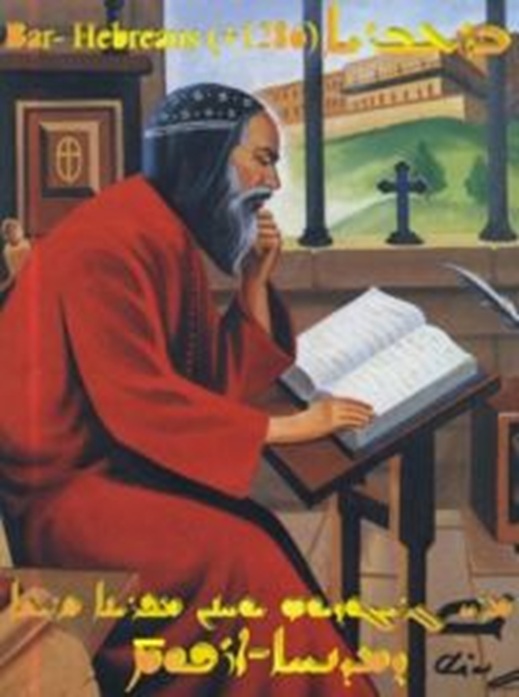
West-Aramean
Syrian Orthodox Gregorios Bar Hebreaus |
12. مفريان شهير من الكنيسة السريانية الأرثوذكسية العالم العبقري ابن
العبري (Barhebreaus)
من ميليطني (ملاطية، تركيا، † 1286) وأيضا العلماء الحديثين يسمونه
"مكتبة القرن الثالث عشر"
بسبب عمق معرفته، يقول في كتابه "الأشعة" [12]:
 "أنتم لم تفسدوني في وحشية علم التنجيم الوثني بل بالعكس جلبتموني إلى
الأمة الآرامية- السريانية البليغة".
"أنتم لم تفسدوني في وحشية علم التنجيم الوثني بل بالعكس جلبتموني إلى
الأمة الآرامية- السريانية البليغة".
 " من آرام، أي سوريا، نقول آراميين [...] معنى السوريين السريان
وأيضا من آرام، أي حران، مدينة الوثنيين، نقول وثني [...]
السريان الشرقيين ليسوا معروفين في كتاب الملوك الأول ونقرأ في الكتاب
الثاني من الملوك (18:26) 'تكلم إلى عبيدك في اللغة
الآرامية'...
ومن الواضح أن المقصود هنا 'السريانية' وليس 'الوثنية'.
وفي رسالة بولس إلى أهل غلاطية2:14))
يقرأون "إن كنت وأنت يهودي تعيش أمميّا "... وهو واضح أن الكتاب يقصد
هنا وثني وليس سرياني".
" من آرام، أي سوريا، نقول آراميين [...] معنى السوريين السريان
وأيضا من آرام، أي حران، مدينة الوثنيين، نقول وثني [...]
السريان الشرقيين ليسوا معروفين في كتاب الملوك الأول ونقرأ في الكتاب
الثاني من الملوك (18:26) 'تكلم إلى عبيدك في اللغة
الآرامية'...
ومن الواضح أن المقصود هنا 'السريانية' وليس 'الوثنية'.
وفي رسالة بولس إلى أهل غلاطية2:14))
يقرأون "إن كنت وأنت يهودي تعيش أمميّا "... وهو واضح أن الكتاب يقصد
هنا وثني وليس سرياني". |
|
12.1
In his book of
the laughable stories, he says [12.1]
"let this book be a religious friend to the reader, whether he be
Muslim, or Hebrew, or Aramean, or a man
belonging to a
foreign country." |
12.1 في كتابه القصص الهزلية، يقول [12.1]:... "دعوا هذا الكتاب أن
يكون صديق ديني إلى القارئ ، سواء كان مسلم ، أو يهودي، أو آرامي،
أو رجل ينتمي إلى بلد أجنبي" |
|
12.2
In his commentary on Genesis 10:22 he says[12.2]: "and
his [Shem] sons (were) the Assyrians, the Chaldeans, the Ludians,
the Syrians, the Hebrews, (and) the Persians."
|
12.2
وفي تفسيره لسفر
التكوين 10:22 يقول[12.2]:"... وأبناء سام هم الآشوريين،
الكلدان، اللوديين (Ludians)،
السريان، واليهود (و) الفرس".
|
|
12.3
In His Syriac dictionary [12.3] he says:
 "Aram
is Inner Syria,
that is Palestine, while outside of Syria is
called Aram-Nahrin." "Aram
is Inner Syria,
that is Palestine, while outside of Syria is
called Aram-Nahrin."
 “The
Syriac tongue is from Aram the son of Shem the son of Noah; the name
is transmitted in Aramaic." “The
Syriac tongue is from Aram the son of Shem the son of Noah; the name
is transmitted in Aramaic." |
12.3 في قاموسه [12.3] السرياني يقول:
 آرام الذي في داخل سوريا
هو فلسطين، بينما خارج سوريا يدعى آرام ما بين النهرين".
آرام الذي في داخل سوريا
هو فلسطين، بينما خارج سوريا يدعى آرام ما بين النهرين".
 " اللغة السريانية هي لغة آرام ابن سام، ابن نوح، الإسم أحيل في
الآرامية"
" اللغة السريانية هي لغة آرام ابن سام، ابن نوح، الإسم أحيل في
الآرامية" |
|
12.4
In his book "Storehouse of Secrets" [12.4] he says:
"That is, that the Syriac was the first tongue, and
not the Hebrew as some think, is known from this, that Abraham was
first called Hebrew because of the crossing of the river Euphrates" |
12.4 في كتابه "مخزن الأسرار" [12.4] يقول: "وهذا هو، أن السريانية
هي اللغة الأولى، وليس العبرية، كما يعتقد البعض، ويُعرف من هذا،
أن إبراهيم كان أول من دعي عبرياً بسبب عبور نهر الفرات" |
|
12.5
In
his Syriac Grammar Books [12.5] he says:
 "The Arameans don't want to mix
with the pagans." "The Arameans don't want to mix
with the pagans."
 "Wash
my tongue with hyssop, so that they speak in the Aramaic language in
the measure of Ephraem, because this is the Syriac way of speaking,
which foreigners do not use." "Wash
my tongue with hyssop, so that they speak in the Aramaic language in
the measure of Ephraem, because this is the Syriac way of speaking,
which foreigners do not use." |
12.5 في كتبه قواعد السريانية [12.5] يقول:
 الآراميون لا يريدون أن يخلطون أنفسهم مع الوثنيين"
الآراميون لا يريدون أن يخلطون أنفسهم مع الوثنيين"
 "اغسل
لساني بالزوفا،
ذلك لأنهم يتكلموا في اللغة الآرامية
على وزن مار أفرام، لأن هذه هي طريقة الحديث السريانية ، التي لا
يستخدمهاالاجانب".
"اغسل
لساني بالزوفا،
ذلك لأنهم يتكلموا في اللغة الآرامية
على وزن مار أفرام، لأن هذه هي طريقة الحديث السريانية ، التي لا
يستخدمهاالاجانب". |
|
12.6
In
his book “Summary
of the Nations”:
[12.6]
"The language of all mankind was one, the Syriac,
and it was divided into three parts. The clearest was Aramaic." |
12.6 في كتابه "موجز من الأمم" [12.6] يقول:
إن لغة البشر كانت واحدة، وهي السريانية، وأنها كانت مقسمة إلى
ثلاثة أجزاء،
وأكثر وضوحا كانت الآرامية"
|
|
13.
The Great Metropolitan Philoxenos Yuhanun Dolabani
(1885-1969), born
in Mardin [Turkey], was one of the outstanding scholars that the
Church has seen in the near past. He wrote many books, in which he
expressed his relationship with the Aramaeandom. In his hymn
[13]
"Love towards the Aramaeandom" he says:
"Because of love towards you, O
Aramaeandom, I have been deeply in love since
childhood. During weakness and strength I will serve you
faithfully." |
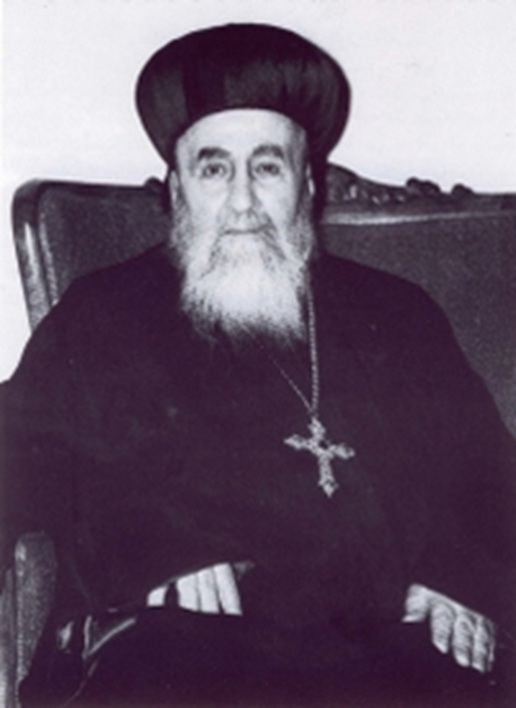
West-Aramean Syrian Orthodox Filoxinos Yuhanun Dolabani |
13. المطران العظيم مار فيلوكسينوس يوحنا دولاباني (1885-1969)، ولد
في ماردين (تركيا) وهو واحد من عمالقة العلماء الذي شهدته الكنيسة في
الماضي القريب.
وكتب العديد من الكتب، وصف فيها علاقته بالآراميّة. في ترتيله "حب
للآراميّة" يقول [13]: "من أجل حبّي لك، يا آراميّة أنا منذ
الطفولة متعمقا في حبّك. في ضعفي وقوتي سوف أخدمك بأمانة". |
|
13.1
In his book of the bee, written 1914 in the monastery of
Deyrulzafaran [Turkey]
[13.1]
he says on Arameans and Aramaic:
"My dear and
beloved Aramean,
in many ways I am indebted to you on account of the racial love of
Adam and the Semitic one of Aram (that burns in my heart)."
"I think, my dear one, . . . that you long for the Aramaic tongue,
the tongue which my ancestors spoke – the lordly and ancient
language. That (language) in which our Lord spoke when he was
dwelling on the earth." |
13.1
في كتابه النحلة، كتبه عام 1914 في دير الزعفران (تركيا)، يقول عن
الآراميين واللغة الآرامية[13.1]: "عزيزي
وحبيبي آرام،
في نواح كثيرة أنا مدين لك بسبب أنّ الحب العنصري لآدم
وسامية آرام (مشتعل في قلبي)".
أعتقد، يا عزيزي،... أنك كنت مشتاقا للغة الآرامية، اللغة التي تكلم
بها أجدادي- اللغة الربانية والقديمة. (اللغة) التي تكلم بها ربنا
عندما كان يعيش على الأرض".
|
|
13.2.
"The Aramaic language is more important to us Arameans
than
any other language, because it is the tongue of our race."
[13.2] |
13.2 "
"اللغة
الآرامية هي أكثر
أهمية لنا من أي لغة أخرى،
لأن هذه هي لغة سلالتنا(عرقنا)". [13.2] |
|
13.3
"And as a careful examination by scholars (shows),
the art of
writing was a discovery of the Arameans;
and among those who
received it were the Greeks and the Romans, and the Saracens (i.e.
Arabs), and the Persians, and the Armenians. Therefore,
for the
Arameans it is a blessing without equal
among all mankind."
[13.3] |
13.3 " كما أن الفحص
الدقيق من قبل العلماء يبين، أن فن الكتابة هو من اختراع الآراميين،
وبين الذين أخذوها عنهم كانوا اليونانيون والرومان، وساراكاين((Saracens)أي
العرب)، والفرس،
والأرمن
ولذلك، فهي بَركة للآراميين
لا يوجد مثلها
بين جميع البشر". [13.3] |
|
13.4
"Aramean
teachers give advice about this and say: do not talk too much,
neither words of wisdom. For the fear of God
and the love of
mankind by the Arameans."
[13.4] |
13.4 "
المدرسين الآراميين يعطون نصيحة ويقولون:
لا تتكلم كثيرا، ولا تتفوه بكلمات الحكمة. لأن مخافة الله ومحبة
البشرية نابعة من الآراميين". |
|
13.5
"Be
therefore
similar like these Arameans: in the fear of God,
and in abundance and in philanthropy toward your brethren and the
members of your race, so that a good remembrance (of that) is
written down for you in books and in the hearts of the Arameandom."
[13.5] |
13.5 " بسبب هذا
كن مماثلاً للسريان:
في مخافة الله، وفي وفرة العمل الخيري تجاه أشقائك وأعضاء عرقك،
حتى يَبقى لك تذكار جيد في الكتب وفي قلوب الآراميين". [13.5] |
|
13.6
"With
the help of our Lord I have arrived at the end. And as a miracle
provides the sweetness
of the essence of the Aramaeandom,
I
have arranged (only) the beginnings for you (and) I ask you to be
very careful with it."
[13.6] |
13.6
بفضل مساعدة ربنا لقد وصلتُ إلى نهاية المطاف.
مثل المعجزة التي توفر حلاوة الجوهر للآراميين،
لقد أعددت لكم البداية فقط وأطلب منكم أن تكونوا حذرين جدا معه".
[13.6] |
|
13.7
In Bar Hebraeus' "Book of the Dove" written by Dolabani in the
monastery of Deyrulzafaran in 1916, he says
[13.7]:
"To you our Aramean reader is this book dedicated,
bearing (many) advantages." |
13.7 في إبن العبري (Bar Hebraeus)
"كتاب الحمامة" الذي كُتب على يد المطران دولاباني في دير الزعفران في
عام 1916، يقول [13.7]:
قارئنا الآرامي لك هذا الكتاب ُكرِّس،
وهو مفيد جدا، وله عِدّة مزايا".
|
|
13.8
In Bar Hebraeus' book "Mush'hotho" written by Dolabani in 1929 in
the monastery of St. Marc in Jerusalem, he says
[13.8]
:
"Bar Hebraeus
has left to the Aramaeandom
an incomparable
preface whose propositions are excellent;" |
13.8 في كتاب إبن العبري
(Bar Hebraeus)
"موشحوثو" كتب
على يد مطران دولاباني في عام 1929 بدير مار مرقس في أورشليم يقول
[13.8]: ابن العبري ترك مقدمة للآراميّة
لا شبيهَ لها،
بها
مقترحات ممتازة". |
|
13.9
"I
beseech the Lord to make them mighty supports
for the exaltation
of the Aramaeandom!"
[13.9] |
13.9 أتضرع إلى الرب لكي يجعلهم دعم قوي لتمجيد ولتعزيز الآراميّة"
[13.9] |
|
13.10
In the book of the poems of Patriarch Yuhanon Bar Ma‘dani written
in Jerusalem in 1929, he says
[13.10]:
"For the benefit of those who love the Aramaeandom, we
were careful to publish this book of memre and verse homilies of Mor
Yuhanon Bar Ma‘dani." |
13.10 في كتاب قصائد البطريرك يوحنا ابن معدني، كتب في أورشليم في عام
1929، يقول[13.10]:
لمصلحة الذين يحبون الآراميّة
كنّا نحرص على نشر كتاب الشعر هذا
والمواعظ الشعرية ليوحنا ابن معدني" |
|
13.11
In his poem of mourning about the death of Naum Faik (†
1930)
[13.11]:
"He was a trombone who raised his voice for our nation and
because of the Aramean language of our fathers he did not stop
blowing in our group." |
13.11 في قصيدته المحزنة عن وفاة نعوم فايق (1930†)
[13.11] يقول:
هو كان البوق، الذي سمّع صوته
لأمتنا
وبسبب الآرامية لغة آبائنا
أنه لم يتوقف عن الهتاف في مجموعتنا". |
|
13.12
In the book of the letters of David Bar Faulus, which he wrote 1953
in Mardin
[13.12]
: "All who love the Aramaeandom are eager to familiarise
themselves concerning his instruction." |
13.12 في كتاب الرسائل داود بار بولوس، الذي كتبه في عام 1953 في
ماردين [13.12] يقول:
جميع الذين يحبون الآراميّة
هم متحمّسون (توّاقون) لمعرفة أنفسهم فيما يتعلق بالإطلاع على
تعليماته". |
|
13.13
"I set out to publish it, and see, with the Lord's help it is
finished; I offer it to dear Aramean readers!"
[13.13] |
13.13 أنا جهزته للنشر، ومع مساعدة الرب ها أنه قد أكمِل، وأقدِّمه
إلى
القراء الأعزاء"
[13.13] |
|
13.14
In the book of the poems of Patriarch Noah,
written 1956 in Mardin, he says
[13.14]:
“That it may it be immediate gain in the hands of
those who
love Aramaic learning."
"See, I offer it today as a tasteful gift to those
who love
Aramaic learning." |
13.14 في كتاب الشعر للبطريرك نوح، كُتب عام 1956 في ماردين، يقول
[13.14]:
"أنه
سوف يكون الربح فوري في أيدي الذين يحبون تعلّم الآرامية"
"انظر،
أقدمه (أعرضه)
اليوم باعتباره
هدية لذيذة للذين يحبون تعاليم الآرامية
" |
|
13.15
"As
the patriarch Noah grew up, he was was educated in our orthodox
faith, and loved humility. He was instructed in the sciences and
learnt the Aramaeandom and the teaching of the faith."
[13.15] |
13.15
البطريرك نوح لما كان يكبر، كان يتلقى تعليمه في عقيدتنا الأرثوذكسية
(إيماننا الأرثوذكسي)، أحب التواضع. وكان يدرس العلوم والآرامية
وتعليم الإيمان" [13.15] |
|
13.16
In the history book of the anonymous from Urhoy about the
afflictions in Edessa, Amid and Mesopotamia, written in 1959 in
Mardin, he says
[13.16]:
"We loved to disseminate it in Syriac, in the language of its
author, so that we might render service with good pronunciation to
our own Aramaic language, and to the writers of our own regions of
Mesopotamia, Nisibis, I mean, and Amid, and Urhoy and the rest." |
13.16
في كتاب تاريخ كاتبه مجهول من الرها (Edessa)
يحكي عن آلام الرها وأمد وما بين النهرين، كُتِب (هذا الكتاب) في
ماردين في 1959 يقول [13.16]:
أحببنا أن ننشره في السريانية، في لغة المؤلف، حتى نتمكن أن نقدم خدمة
جيدة للغتنا الخاصة بلفظ صحيح النطق، وإلى المؤلفين في مناطقنا من بلاد
ما بين النهرين، يعني نصيبين، أمد، رها وإلى آخره"... |
|
13.17
In the book of the wisdoms of the Aramean sage Ahiqar written in
1962 in Mardin, he says
[13.17]:
"The primacy of the ancient writings in the Aramaic language
is undeniable, because before all languages its culture advanced
and its wisdom was disseminated." |
13.17 في كتاب الأحكام للعبقري الآرامي أحيقار، كُتِب في 1962 في
ماردين، يقول [13.17]:
" للكتابات القديمة في اللغة الآرامية أهمية كبيرة لا يمكن إنكارها،
لأن ثقافتها المتقدمة وحكمتها كانت منتشرة قبل كل اللغات" |
|
The
Scholars of the West- Syrian Catholic Church |
علماء الكنيسة السريانية الكاثوليكية الغربية |
|
14.
Clemens Joseph David,
born 1829 in Amadiye [Iraq] and passed away in
the year 1890, was ordained Archbishop of Damascus in 1879. He
studied in Mosul and was both an excellent scholar in Arabic and
Syriac. In his Dictionary he writes:[14]
“And when the Arameans converted to Christianity they forgot about
their (Aramaic) name, and were called Syrians distinguishing them
from the heathen Arameans.”
14.1
"The
Syrian nation has the honour of belonging to Aram...[14.1] |
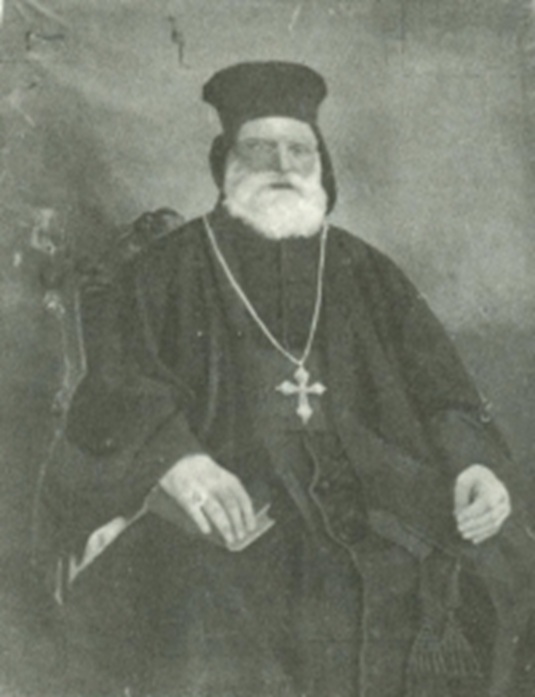
West-Aramean Syrian Catholic Clemens Joseph David |
14.
قليمنس يوسف داود ولد في عام 1829 في العمادية (العراق) وتوفي في عام
1890، عُيِّن مطرانا لدمشق في عام 1879.
درس في الموصل وكان باحثا ممتازا
في العربية والسريانية. في قاموسه يقول[14]:
وعندما
الآراميون اعتنقوا المسيحية،
نسوا إسمهم الآرامي، ودعيوا سريان ليميزوا أنفسهم عن الآراميين
الوثنيين"
14.1"الأمّة
السورية (السريانية) تتشرف بأن تنتمى إلى آرام...." |
|
15.
Ishak Bar Armalto, born 1879 in
Mardin [Turkey] and passed away in 1954 in Beirut [Lebanon], made
significant contributions to Syriac studies and had a profound
knowledge of the syriac manuscripts. He also wrote a book about the
Genocide on the Arameans in 1919.
In his book [15] about the “eagerness of children”
written in 1908 ,he honours the glories of the Aramaean Civilization
and says:
 "Discourse
on the glorious deeds of the Arameandom" "Discourse
on the glorious deeds of the Arameandom"
|

West-Aramean Syrian Catholic Ishak Bar Armalto |
15.
إسحاق بار أرملتو ولد في عام 1879 في ماردين (تركيا) وتوفي في عام 1954
في بيروت (لبنان)،
قدَّم مساهمات كبيرة في
الدراسات السريانية، وكان له معرفة عميقة في المخطوطات السريانية.
وأيضا هو كتب كتاباً عن الإبادة الجماعية للآراميين في عام 1919. في
كتابه [15] عن "حماس الأطفال" في 1908، يحترم الحضارة الآرامية الممجدة
ويقول:
 الحديث عن الأفعال الآراميّة المجيدة"
الحديث عن الأفعال الآراميّة المجيدة" |
 "Let us arrive to … so as to examine and talk about the
exalted
glorious deeds and the beautiful virtues of the Arameandom
and raise and build our foundations on the foundations of her wise
teachers and eminent scribes." "Let us arrive to … so as to examine and talk about the
exalted
glorious deeds and the beautiful virtues of the Arameandom
and raise and build our foundations on the foundations of her wise
teachers and eminent scribes." |
 دعونا نصل إلى...لنبحث ونتحدث عن الأعمال المجيدة والمحترمة وكذلك
عن الفضائل الجميلة للآراميين ونرفع ونبني مجتمعاتنا على أساس
المعلمين البارزين المملوئين حكمة ".
دعونا نصل إلى...لنبحث ونتحدث عن الأعمال المجيدة والمحترمة وكذلك
عن الفضائل الجميلة للآراميين ونرفع ونبني مجتمعاتنا على أساس
المعلمين البارزين المملوئين حكمة ". |
 "And
these [aforementioned] things altogether complete the Arameandom,
[which is] rich in treasures." "And
these [aforementioned] things altogether complete the Arameandom,
[which is] rich in treasures." |
 " وهذه الأشياء المذكورة أعلاه مع بعضها جميعا تجعل الآرامية
كاملة،
وهي غنية في الكنوز"
" وهذه الأشياء المذكورة أعلاه مع بعضها جميعا تجعل الآرامية
كاملة،
وهي غنية في الكنوز" |
 "Since
man can conquer and be conquered, it follows from this that
language, too, can exalt and be exalted, although the
Aramaic
literature is in many and various ways more precious and excellent
than the rest of the languages." "Since
man can conquer and be conquered, it follows from this that
language, too, can exalt and be exalted, although the
Aramaic
literature is in many and various ways more precious and excellent
than the rest of the languages." |
 لأن الإنسان يمكن أن
يفوز أو ينهزم
لأن الإنسان يمكن أن
يفوز أو ينهزم
ويستنتج من ذلك أن اللغة، أيضا، يمكن أن تُمجِّد أو تتمَجَّد
ورغم أن الأدب الآرامي طرقه مختلفة، له قيمة ممتازة أكثر مما لبقية
اللغات". |
 "Aramaeandom
has other achievements and is adorned by other splendours. When
the human race multiplied on earth and became involved in
experimenting in various sciences and crafts, they managed to devise
writing, and these same Arameans were the first to achieve renown
in this: they put into written records their practices, customs
and new discoveries. It was from them that the Phoenicians, Greeks,
Romans and Egyptians learnt, and then taught other peoples. We also
encounter the splendid and distinctive accomplishments of
Aramaeandom when reflect and realize that from the Greeks the
Syrians first took over learning and knowledge through the labour of
their hands and the sweat of their brow; then, without wearying, and
without receiving any reward, they transmitted it to the Arabs, and
from them the Latins wisely took it over in a surreptitious way." "Aramaeandom
has other achievements and is adorned by other splendours. When
the human race multiplied on earth and became involved in
experimenting in various sciences and crafts, they managed to devise
writing, and these same Arameans were the first to achieve renown
in this: they put into written records their practices, customs
and new discoveries. It was from them that the Phoenicians, Greeks,
Romans and Egyptians learnt, and then taught other peoples. We also
encounter the splendid and distinctive accomplishments of
Aramaeandom when reflect and realize that from the Greeks the
Syrians first took over learning and knowledge through the labour of
their hands and the sweat of their brow; then, without wearying, and
without receiving any reward, they transmitted it to the Arabs, and
from them the Latins wisely took it over in a surreptitious way."
|
 الآراميّة لها إنجازات أخرى وهي مزينة من روائع أخرى.
الآراميّة لها إنجازات أخرى وهي مزينة من روائع أخرى.
عندما تضاعف الجنس البشري على الأرض وأصبحت مشاركته في تجارب مختلفة من
العلوم والحُرَف اليدوية (الفن)،
تمكّنوا من إبتكار الكتابة،
وهم
نفسهم (السريان) الأولين الذين كانوا مشهورين في هذا:
لقد إحتفظوا بمحاضر
مكتوبة فيها
ممارساتهم،
وتقاليدهم واكتشافاتهم الجديدة،
ومنهم
قد تعلم الفينيقيين واليونانيين والرومان والمصريين وبعد ذلك علموا
الشعوب الأخرى.
كما أننا سنأتي إلى الأداء
المتميز للآراميين
إذ نتصور ونُدرك أن السريان قبل اليونانيين أخذوا العلم والمعرفة من
خلال عمل أيديهم وعرق جبينهم،
وأيضا، دون ملل، ودون الحصول على أي مكافأة، وأنهم أحالوها إلى العرب،
ومنهم أخذها اللاتين فاستولوا عليها بحكمة وبطريقة خادعة".
|
 "You,
my beloved Aramaic friends, need to learn to read and steep yourself
in this language to embrace the breath and amplitude of your fathers "You,
my beloved Aramaic friends, need to learn to read and steep yourself
in this language to embrace the breath and amplitude of your fathers |
 وأنت، يا حبيبي الآرامي وصديقي، أنت بحاجة إلى أن تتعلم قراءة هذه
اللغة وتُطوِّر نفسك فيها
لاحتضان نَفَس آبائك والإتساع سعة أجدادك"
وأنت، يا حبيبي الآرامي وصديقي، أنت بحاجة إلى أن تتعلم قراءة هذه
اللغة وتُطوِّر نفسك فيها
لاحتضان نَفَس آبائك والإتساع سعة أجدادك" |
|
The Scholars of the West- Syrian Maronite Church |
علماء الكنيسة السريانية المارونية الغربية |
|
16.
Paul Assemani (1878-1944)
was from the famous Maronite family
Assemani, which produced a number of excellent scholars and played a
magnificent role in introducing the Syriac heritage to the West. He
wrote a History of Syriac Literature in Arabic. He Says regarding
the Aramean nation: [16] |
16. بول أسّيمانيPaul Assemani (1878-1944
كان من أسرة أسّيماني
المارونية الشهيرة، التي تمخضت عدد من
العلماء الممتازين
ولعبت دورا كبيرا في عرض التراث السرياني على الغرب
كتب تاريخ الأدب السرياني في اللغة العربية. ويقول فيما يتعلق بالأمة
الآرامية [16]:
|
|
16.1.
"The Arameans are the sons of Aram, son of Shem.
They settled since old times in the large Aramean
countries which were stretched from Persia in the East, and from
the Mediterranean in the West and Armenia and Asia Minor in the
North and Arabian Peninsula in the South. Their lands were Bayblon,
Assyria, Mesopotamia, Syria, Lebanon, Palestine." |
16.1
الآراميون هم أبناء آرام، إبن سام. إستوطنوا منذ العصور القديمة في
بلاد آرام
التي تمتد من بلاد فارس في الشرق إلى البحر الأبيض المتوسط في الغرب
وأرمينيا وآسيا الصغرى في الشمال وإلى شبه الجزيرة العربية في الجنوب.
بلادهم كانت بابل،
والإمبراطورية الآشورية، وبلاد ما بين النهرين، سوريا، لبنان وفلسطين |
|
16.2.
"The Arameans were in Aram which was from Persia to the
Mediterranean, and they all were called Arameans,
but when the Greeks seized the area they called it Syria." |
16.2
الآراميون كانوا في آرام الذي كان يمتد من بلاد فارس إلى البحر الأبيض
المتوسط، وكانوا يُدعون جميعهم آراميين،
ولكن عندما اليونانيون إستولوا على المنطقة، دعوها سوريا" |
|
17.
Paul Al-Khoury Al-Kfarnissy
(1888-1963)
was professor of Syriac at the Lebanese Maronite Order.
His writings include an unpublished history of Syriac literature.
His Grammar of the Aramaic Syriac Language is one of the best
written Syriac grammars produced in Arabic. He says on the Aramean
people: [17]
 "The
Arameans are the sons of Aram...their
country is the area stretched from Persia in the east, from the
Mediterranean in the west, from Armenia and Minor Asia in the north,
and from Arabia in the south." "The
Arameans are the sons of Aram...their
country is the area stretched from Persia in the east, from the
Mediterranean in the west, from Armenia and Minor Asia in the north,
and from Arabia in the south."
 "After
they became Christians the Arameans began leaving their old Aramean
name to call themselves Syrians...I wish they had never changed
their old Aramean name." "After
they became Christians the Arameans began leaving their old Aramean
name to call themselves Syrians...I wish they had never changed
their old Aramean name."
 "Now
I seek you, the children of Aram, what ever is your church
denomination to remember your high origin and glorious history
and to take care of your noble language..." "Now
I seek you, the children of Aram, what ever is your church
denomination to remember your high origin and glorious history
and to take care of your noble language..." |
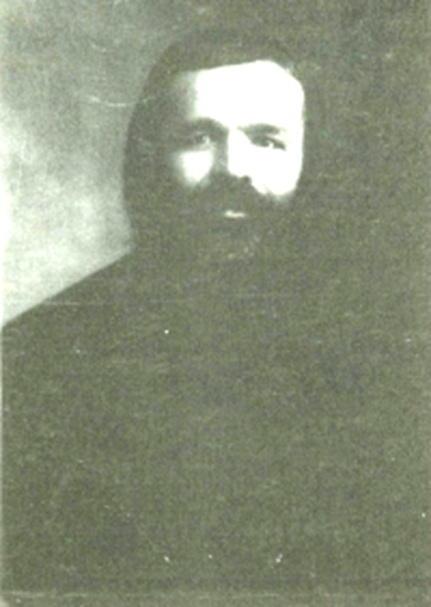
West-Aramean Syrian Maronite Paul Al-Khoury Al-Kfarnissy |
17. بولس الخوري الكفارنيسي
(Kfarnissy)
(1888-1963)
كان
بروفيسوراً عالماً في اللغة السريانية في دير المارونيين في لبنان.
كتاباته غير المنشورة تشمل تاريخ أدب السريان.
وقواعد اللغة الآرامية (السريانية) وهي واحدة من أفضل المكتوبات التي
انتشرت في
اللغة
العربية. وهو يقول عن الشعب الآرامي [17]:
 " الآراميون هم أبناء آرام...
وبلدهم هو: المنطقة التي تمتد من بلاد فارس في الشرق إلى البحر الأبيض
المتوسط في الغرب، ومن آسيا الصغرى وأرمينيا في الشمال إلى شبه الجزيرة
العربية في الجنوب"
" الآراميون هم أبناء آرام...
وبلدهم هو: المنطقة التي تمتد من بلاد فارس في الشرق إلى البحر الأبيض
المتوسط في الغرب، ومن آسيا الصغرى وأرمينيا في الشمال إلى شبه الجزيرة
العربية في الجنوب"
 والآراميون بعدما أصبحوا مسيحيين، بدأوا ترك إستخدام إسمهم الآرامي
القديم ، ودعوا أنفسهم سريان.... كنتُ أتمنى أن لا يُغيِّروا أبدا
اسمهم (الآرامي) القديم"
والآراميون بعدما أصبحوا مسيحيين، بدأوا ترك إستخدام إسمهم الآرامي
القديم ، ودعوا أنفسهم سريان.... كنتُ أتمنى أن لا يُغيِّروا أبدا
اسمهم (الآرامي) القديم"
 "
الآن أطلب منكم، أنتم أبناء آرام،
أيا ما كان مذهب كنيستكم، أن تتذكروا أصلكم السامي وتأريخكم المجيد
وأيضا أن تهتموا برعاية لغتكم النبيلة"...
"
الآن أطلب منكم، أنتم أبناء آرام،
أيا ما كان مذهب كنيستكم، أن تتذكروا أصلكم السامي وتأريخكم المجيد
وأيضا أن تهتموا برعاية لغتكم النبيلة"... |
|
The
Scholars of the West-Syrian Melkite Church |
علماء الكنيسة الملكية الغربية |
|
18.
Agapius of Hierapolis/Mabbug [Iraq]
was a 10th century bishop. His
world History features accounts of the world from its creation to
the year 941/942. [18] He Says about king Syrus: "At
that time [42 years after Moses was born] lived King Syrus. His rule
was in Damascus. Syria was called by his name." |
18.
أجابيوس من حيرابوليس / مابّوغ (العراق) كان مطران من القرن العاشر.
كتابه "تاريخ العالم"
يعطي لمحة عامة من إنشاء العالم حتى سنة 941/942 [18] يقول عن الملك
سيروس:
وفي ذلك الوقت (42 عاما بعد ولادة موسى) عاش الملك سيروس. وكان حكمه في
دمشق. وسوريا دعيت على اسمه". |
Footnotes
[1] (C.W. Mitchell, S. Ephraim's Prose Refutations of
Mani, Marcion and Bardaisan (2 vols.; London & Oxford: Williams & Norgate,
1912 & 1921), vol. II, p. 225)
[1.1] (See Sidney H. Griffith, "Julian Saba, `Father of
the Monks' of Syria," Journal of Early Christian Studies 2 (1994), esp. pp.
201-203)
[1.2] (C.W. Mitchell, S. Ephraim's Prose Refutations of
Mani, Marcion and Bardaisan (2 vols.; London & Oxford: Williams & Norgate,
1912 & 1921), vol. II, p. 225.
[1.3] See O. G. von Wessendonk, "Bardesanes and Mani,"
Acta Orientalia 10 (1932), pp. 336-363)
[1.4] See Priest Joseph Demir, Pentiqotho, 1981
Heilbronn, p. 202
[2] See Joseph P. Amar, A Metrical Homily on Holy Mar
Ephrem by Mar Jacob of Sarug (Patrologia Orientalis, vol. 47, fasc., 1, no.
209; Turnhout: Brepols, 1995), #48, pp. 37ff.
[2.1] Syriac Manuscripts from the Vatican Library: Volume
1, VatSyr. 117 number 108. On Addai the Apostle and Abgar the King of
Edessa. Fol. 268a, p. 537
[2.2] Words, Texts And Concepts Cruising The
Mediterranean Sea: Studies On The Sources, Contents And Influences Of
Islamic Civilization And Arabic Philosophy And Science : Dedicated To
Gerhard Endress On His Sixty Peter Bruns' Ein Memra des Jakob von Serug Auf
Edessa und Jerusalem, p. 546
[2.3] see [2.2] p. 549
[2.4] Text tr. A. Roberts and J. Donaldson (eds.),
Ante-Nicene Fathers, vol. 8 (1886);
See Syriac Manuscripts from the Vatican Library: Volume
1, VatSyr. 117, number 224:On Shmona and Gurya. Fol. 551a, p. 1099
[3] Syriac Manuscripts from the Vatican Library; Volume
1, VatSyr 37: Life of St. Abhai, Bishop of Nicea. Fol. 144b (156b), p. 314,
315
[4] Syriac Manuscripts from the Vatican Library; Volume
1, VatSyr 135, number 6: A letter by Bishop Simeon of Beth Arsham concerning
Barsauma and the heresies of the Nestorians. Fol. 24a , p. 56
[5] (Maurice Brière, Les Homiliae Cathedrales de Sévère
d'Antioche Traduction Syriaque de Jacques d'Edesse (Suite) Homelies CXX A
CXXV in F. Graffin, Patrologia Orientalis Tome XXIX-Fasicule 1, p. 196)
[6] (Schtoth Yaume: Hexaemeron, Die Schöpfungslehre des
Jakob von Edessa (+708). Nach der Estrangelo Handschrift, die 839 n. Chr.
geschrieben wurde; abgeschrieben von Erzbischof J.J. Cicek, Verlag Bar
Hebräus, Losser-Holland 1985, p. 60)
[7] The Chronicle of Zuqnin, Parts III and IV, English
translation by Amir Harrak [Toronto, 1999], p. 41
[7.1] see [7], p. 163
[7.2] see [7] p. 225
[7.2] see [7] p. 226
[8] Monk Anton of Tigrit "The knowledge of Eloqeunce",
Chapter 5
[9] The Bishop Moses Bar Kepha: "The Six Days", First
article, Chapter 44, Chapter 45, 2e article, Chapter 45
[10] A. Mingana, The work of Dionysius Bar Salibi against
the Armenians, in Woodbrooke Studies, Vol.4, (Cambridge, 1931) p. 54
[10.1] A. Mingana, A Treatise of Bar Salibi Against the
Melchites (Cambridge, 1931), p. 57
[10.2] Bishop J.E. Manna, Chaldean-Arabic Dictionary,
Babel Center Publications. Beirut 1915, p. 11-21
[11] Syriac text of Chabot edition, published in Paris
1899-1918, p. 3
[11.1] see [12], p. 23
[11.2] see [12], p. 748
[11.3] see [12], p. 496 Livre XII Chapitre VII
[12] Bar Hebraeus, The book of the Rays, by the Syriac
Federation of Sweden, 1983, preface
[12.1] Bar Hebraeus, The Laughable Stories, written off
by Bishop Julius Cicek, Verlag Bar Hebräus, Losser-Holland 1984, preface
[12.2] World Chronicle of Bar Hebraeus, written off by
Malphono Barsaumo Dogan, Verlag Bar Hebräus. Losser-Holland 1987, p. 5
[12.3] R. Payne Smith, Thesaurus syriacus, Oxford
1879-1901, Volume 1, columne 388
[12.4] M. Sprengling & W.C. Graham, Barhebraeus' Scholia
on the Old Testament (Oriental Institute publications 13).
Chicago 1931, p. 45)
[12.5] Bar Hebraei Grammatica Syriacae, ed. Ernst
Bertheau, Göttingen 1843, p. 2
[12.6] Patriarch A. Barsaum, The Syrian Orthodox Church
of Antioch: Its Name and History, published by the syriac organizations in
Middle Europe and Sweden 1983, p. 27
[13] Bron:
Hikmet, Vol. 8, Nr. 4/86 (Mardin, 1954), p.85
[13.1] Preface of Mor Philoxenos Yuhanun Dolabani's book
of the bee [kthobo d-deburitho], published by Verlag Bar Hebräus,
Losser-Holland, 1986
[13.2] See [13.1], page 16
[13.3] See [13.1], page 22
[13.4] See [13.1], page 46
[13.5] See [13.1], page 47
[13.6] See [13.1], page 58
[13.7] Preface of "The Book of the Dove", published by
Verlag Bar Hebräus, Losser-Holland 1983
[13.8] "kthobo d-Mush'hotho" [Book of the Poems],
published by Verlag Bar Hebräus, Losser-Holland 1983, C
[13.9] See [13.8], O
[13.10] Preface of "Mimre d-Bar Maadani" [Poems of Bar
Maadani], ND Holland 1980
[13.11] Published in the book "Naoum Fayeq: Dhikra
wa-Takhlid", by Murad Cheqqe, p. 129-130, Damascus 1936
[13.12] Preface of "kthobo d-egrothe d-david bar faulus"
[book of the letters of David Bar Faulus], published by the syriac printing
of wisdom, Mardin, 1953
[13.13] See [13.12], page 1
[13.14] Preface of "kthobo d-mush'hotho d-fateryarkho nuh
lebnonoyo" [book of the poems of Patriarch Noah from Lebanon], published by
the syriac printing of wisdom, Mardin, 1956
[13.15] See [13.14], page 2
[13.16] Preface of "Makthbonuth zabne ulsone" [History of
the Afflictions], published by Verlag Bar Hebräus. Losser-Holland 1984
[13.17] "The story of Ahikar is said to be from the
beginning of Aramean culture...and Aramean pupils should read it because of
its benefits. Preface of "Ahikar" published in Holland ,1981
[14.] preface of Grammaire de la langue Arameenne,
Deuxième Edition, Mossul, 1896
[14.1] Kitab al-Lumaa al-Shahiya fi Nahu al-Lugha
al-Suryaniya, printed in Mosul, 1896, p. 17-18
[15] see introduction of Kthobo d-regath shabre, printed
in the syriac patriarchate in the school of Sharfe Lebanon, 1908
[16] Lumaa Tarikhiya fi Fara'id al-Adab al-Suryaniya [= a
short history of Syriac literature], Jerusalem 1933
[17] Grammaire de la langue Araméene syriaque, second
edition, Beirut 1962
[18] Kitab al-Unwan according to the edition of Jesuit
fathers, Beirut 1907
|
The scholars of the
East-Syrian Church
The East- Syrian (“Nestorian”) Church (Since
1976 called “Apostolic Assyrian Catholic Church)
The East-Syrian Chaldean church of Babylon.
|
علماء (دارسون) الكنيسة السريانية الشرقية
الكنيسة السريانية الشرقية ( "النسطورية" )
(ومن سنة 1976 تدعى الكنيسة الأشورية الرسولية الكاثوليكية )
الكنيسة السريانية الشرقية في بابل |
|
1.
Simon Bar Sabbae (†
344), was bishop and the second Catholicos of Seleucia-Ctesiphon
after Papa. He was killed by King Shapur II. On the martyrdom of
Simon Bar Sabbae and his companions we read[1]: |
1.
سمعان بار صبّاي (344U),
كان مطراناً وبعدئذ أصبح ثاني مفريان (كاثوليكوس) لسيليسية –كتيسيفون.
وقتِل بواسطة الملك شابور الثاني. عن استشهاده ورفاقه نقرأ: [1]: |
|
1.1.
"And from Khuzestan [ancient Elam] he [King Shapur II] wrote an
edict to the rulers of Beth-Oromoye"
|
1.1
. وكتب (الملك شابور الثاني) مرسوم من خوزستان (ايلام سابقا) إلى حكام
بيت الآراميين
بيث
أورومويى
|
|
1.2.
"These (things) were written by King Shapur [II; 309-379 AD] from
Khuzestan to the rulers of
Beth-Oromoye." |
1.2
. كُتبَت هذه (الأشياء) من قبل الملك شابور
[;II309-379
ميلادية] من خوزستان إلى حكّام بيت الآراميين
بيث
أورومويى
|
|
1.3.
"But that deceiver also came to [the city of] Mahuze, which belongs
to Beth-Oromoye, and he
deceived myriads of Jews." |
1.3
. لكن ذلك المخادع جاء أيضا إلى (مدينة) ماهوز التابعة إلى
بيث أورومويى
وخدع كثيرين من اليهود. |
|
1.4.
"Then, suddenly, a third edict sent by King Shapur [II; 309-379 AD]
from Khuzestan came to the rulers of
Beth-Oromoye." |
1.4.
ثم، فجأة، وصل مرسوما ثالثا من الملك شابور [;II309-379
م.] من خوزستان إلى حكّام بيت الآراميين
بيث أورومويى
|
|
2.
In the
Chronicle of Arbela[2], considered to be from 6th
century, we read about the life of twenty bishops of the Church of Adiabane until 6th century. The writer’s name is
Meshihâ-zkhâ: |
2.
في قائع أربيلّة (
Arbela)
[2]، يعتبر من القرن السادس، نقرأ عن حياة عشرين أسقف من كنيسة أديابان
حتى القرن السادس. وإسم المؤلّف مشيحا زخا: |
|
2.1.
About the Bishop Hairan of Arbela (225-258
A.D) he says:
"Following after ‘Ebed Mešiha was the blessed Hairan, who was
from Beth Aramaye. .. In his time
were many wars between the Romans and Parthians. And an
Artabanus112, the grand king of the Parthians, pushed into the land
of the Romans. And he set ablaze many cities
of Beth Aramaye. …And in earlier times the Persians sought to
pounce on the throne of the Parthians, and many times they tested
their power in battle … First they fell on Mesopotamia,
on Beth Aramaye, on Beth Zabdai
and Arzun."
|
2.1.
عن سيرة مطران حيران من أربيلة (225-258 م.) يقول:" تباعا بعد عبد
مشيحا كان حيران المبارك الذي أصله من
بيث آرامايى (=أورومويى).
في وقته كانت عدّة حروب بين الرومان والفرس. وأرتابانوس 112، الملك
العظيم من الفرس توغل في داخل الأرضي الرومانية وأحرق عدة مدن من
بيث
آرامايى....
وفي أوقات سابقة حاول الفرس السعي للإنقضاض على عرش اليونان، ومرات
كثيرة تدرّبوا على الصراع في ميدان المعركة... أوّلا هجموا على ما بين
النهرين، على
بيث آرامايى
وعلى بيث زبداي وأرزون".
|
|
2.2.
About
Bishop Šahlupa of Arbela (258-273 A.D.) he says:
"Following Hairan, who is worthy of honor among the saints, was
Šahlupa, zealously caring and hard-working in fear of God. Also this
holy father was from Beth Aramaye." |
2.2.
عن سيرة مطران صاهلوبا من أربيلة (258-273 م.) يقول:" خلف حيران،
الذي يستحق التكريم بين القديسين،
كان صاهلوبا مساعدا متحمسا وعاملا بمخافة الله
. وأيضا هذا الأب القديس كان من
بيت آرامايى".
|
|
2.3.
About
bishop Aha d-Abuhi of Arbela (273-291 A.D.) he says:
"And in unanimity they both choose of the entire people Papa,
the Aramaean,
a smart and wise man." |
2.3.
عن سيرة مطران آخا دابوهي من أربيلة (273-291 م.) يقول: " واختاروه
بالإجماع من بين جميع
الشعب بابا الآراميين،
رجلا ذكيا وحكيما" |
|
3.
Severus Sebokht, born in 575 in Nisibis and passed away in 666/67,
was bishop of the famous school of Qenneshrin (the "Eagle's nest").
Severus was a brilliant scholar. Regarding Arameans who became
Christians he says:
“But some of the Syrians who had entered deeply Christianity like
Bardaisan who
was known as the Aramean Philosopher”
|
3.
سويريوس سيبوهكت، ولد عام 575 في نصيبين وتوفى عام 7/666، كان مطرانا
في المدرسة المشهورة قنشرين (عش النسور). وهو (سويريوس) كان عالما
لامعا. يقول عن الآراميين الذين صاروا مسيحيين: "لكن بعضا من
السريانيين الذين دخلوا عميقا جدا في المسيحية كما باردايصان
المعروف بالفيلسوف الآرامي".
|
|
4.
The Chronicle of Khuzistan (Iran), is written by an Aramean
Christian from Khuzistan. The Syriac text is considered to be
written around 680 A.D. About the realtion
between Isho Yahb and King Khosrau II Parvez (598-628) of Perzia we
read:
"YeshuYahb was treated respectfully throughout his life, by the king
himself and his two christian wives
Shirin the Aramean and Mary the Greek". |
4.
وقائع (تاريخ) خوزستان ( إيران) كُتب على يد أحد الآراميين المسيحيين
من خوزستان. النص السرياني يُعتقد أنه كتب في عام نحو 680 م.
عن العلاقة بين إيشو ياهب والملك خوسرو
II
فارويز (598-628) من الفرس نقرأ: يشوع ياهب
كان يعامل خلال حياته بكل إحترام من قبل الملك نفسه وزوجتيه
المسيحيتين، شيرين الآرامية
وماري اليونانية". |
|
5.
Garden of Delights ("Gannath Bussame") written around the 8th/9th
century
is a writing of the “Nestorian” Church of the East. We read
amongst others:
"He interprets this [oracle] plentifully - i mean this multiform
oracle -
somewhere in Pethor of Aram-Nahrin" |
5.
حديقة المسرّات [5] ("كانّاث بوسّامى") كُتب حوالي القرن الثامن أو
التاسع وهو كتابة من الكنيسة النسطورية الشرقية. نقرأ بين أمور أخرى:
هو يفسر هذه المقولة [اوراكيل] بوفرة - أقصد هذه الأوراكل
المتعددة الأشكال في مكان ما من
فيتور آرام بين نهرين
|
|
6.
The author of the chronicle of Se’ert
[6] is unknown.
However it is written by the East-Syrian “Nestorian” Church in
Persia and Middle-East and deals about the life of clergy of this
church. The chronicle is probably written in the 9th
century. We read amongst others: |
.
6
. مؤلف تاريخ سعيرت غير معروف. [6] ولكن كتب من قبل السريان الشرقيين
"النساطرة" كنيسة بلاد فارس والشرق الأوسط ويحوي حياة رجال دين هذه
الكنيسة. هذه السيرة ربما كُتبت في القرن التاسع نقرأ بعض منها:
|
|
6.1.
About the history of Catholicos Babai we read: "Having been
fulfilled, all the fathers chose an inhabitant of Seleucia, relative
of the astrologer Mousa, and secretary of Marzban of
Beth Aramaye.
He was called Babai, son of Hormizd." |
6.1.
عن تاريخ مفريان باباي نقرأ: "مثلما جرى، جميع الآباء اختاروا أحد
سكان سيلوسيا، وهو من أقرباء عالم النجوم موسى. وسكرتير مارزبان
من بيت آرامايى كان يدعى
باباي، ابن هورميزد" |
|
6.2.
About the History of St. Abraham the Great we read: "The daughter
of one of the notables of Nisibis was possessed by a demon, who
tormented her much. God wanted to manifest the virtues of Mar
Abraham, the demon shouted by the mouth of this girl: 'Misfortune
with me! Here that this Aramean dressed
in a coat and who lives in the School, drives me out and
torments me.'" |
6.2.
عن تاريخ مار ابراهيم الكبير نقرأ: إبنة أحد نبلاء نصيبين كانت
مسكونة بشيطان وكان يعذبها كثيرا. كان الله يريد أن يُظهر حسنات مار
ابراهيم، صرخ الشيطان من خلال فم هذه البنت: حظي سيء! ها،
هذا الآرامي الذي يلبس
ثوبا
ويعيش في المدرسة، يطردني ويعذبني |
|
6.3.
About the history of Mar Aba the Great we read: "He was scribe of
Marzban of Beth Aramaye, who lived
in Radan." |
6.3.
عن تاريخ مار آبا الكبير نقرأ: "كان سكرتيرمارزبان في
بيت آرامايى، الذي كان
ساكنا في رادان". |
|
Beth Aramaye/ Beth Oromoye
 |
|
6.4.
About the History of Catholicos Joseph we read: "This man spend
the greatest part of his life in the Greek empire, where he learned
medicine. Back to Nisibis, he settled some time in a monastery and
became attached to an Aramean king,
who had then in this place the responsibility of Marzban." |
6.4.
عن تاريخ مفريان (كاثوليكوس) يوسف نقرأ: "هذا الرجل عاش الجزء الأكبر
من حياته في الإمبراطورية اليونانية، حيث أنه تعلم الطب. أثناء عودته
إلى نيصيبين استقر بعض الوقت في الدير
وأصبح مرتبطا بملك آرامي،
الذي كان لديه في ذلك الوقت مسؤولية
مارزبان". |
|
6.5.
About mortality rate at the time of Joseph we read: "Here is an
anecdote relative to this plague. The inhabitants of Beth Armaye
were all removed by the death; there remained only seven persons and
a young boy." |
6.5.
عن معدل الوفيات في زمان يوسف نقرأ: "هنا طرفة ذات صلة بالوباء).
سكان بيت آرامايى
أصابهم الفناء وبقي هناك فقط سبعة أشخاص وصبي صغير". |
|
6.6.
About History of Rabban Haia we read: “After Mar Abraham's death,
Raban Haia went to the desert of Egypt and prayed to Jerusalem.
The divine grace called him then
to return to Aramean ground and to build a convent in the
region of Cascar." |
6.6.
عن تاريخ الربّان هايا نقرأ: "بعد وفاة مار ابراهيم الأب هايا ذهب
إلى صحراء مصر وصلى من اجل القدس. النعمة
الإلهية دعته إلى العودة للأرض الآراميية
لكي يشيد دير في منطقة
كسكار".
|
|
7.
Catholicos-Patriarch Timotheos I
of the Syrian (“Nestorian”) Church
of the East (born in Hazza (Erbil), Iraq,
†
9.1. 823 in Baghdad) says to other East-Syrian bishops about Mor
Yeshu'zkho [7]:
Mor Yeshu'zkho the
Aramean, episcopos (from the city of) Seleucia…..
About Catholicos Dodyeshu he says:
“Catholicos Dodyeshu'
the Aramean…”
About the famous bishop Isaac the Syrian (or: Isaac of Nineveh†
700) he says,, This useful Mimro
(sermon) of Isaak, the Syrian, is
finished. His prayer be with us." |
7.
مفريان– بطريرك طيموثاوس الأول للكنيسة السريانية الشرقية
(النسطورية) (ولد في هازّا (اربيل)، العراق،
♱823-1-9)
يقول إلى مطارنة السريان الشرقيين الآخرين عن مطران مار يشوع’زاخو
[7]: "مار يشوع’زاخو الآرامي أسقف
من (مدينة) سيلوسيا..... عن مفريان – بطريرك دوديشوع يقول: "مفريان
(كاثوليكوس) دوديشوع الآرامي...
عن المطران المشهور اسحاق السرياني (أو: اسحاق النينوي
♱
700) يقول: هذه القصيدة (ميمرو) المفيدة من
اسحاق السرياني
قد انتهت، صلواته معنا". |
|
8.
Isho Barnun (†
827)
[8], who was taught by Mar Abraham bar Dashandad in
the Upper Monastery at Mossul, succeeded Timotheos I as patriarch.
He says: "Syria was thus called by the
name of Syrus, who having killed his brother, reigned in
Mesopotamia, and hence the whole region during his reign was called
Syria. But in ancient times
Syrians were called Arameans….
We know that the Aramean language in which Abraham spoke
was the Syriac." |
8.
إيشو
بارنون (827†
)
[8], الذي تلقى تعليمه من مار ابراهيم بار داشانداد في دير العالي في
الموصل، أصبح بطريركا بعد طيموثاوس الأول. يقول: "سوريا سميت على اسم
سيروس، الذي بعد ما قَتل
شقيقه ، كان يحكم بلاد ما بين النهرين ، وبالتالي دعيت المنطقة كلها
خلال فترة حكمه سوريا. ولكن في
العصور القديمة السوريين كانوا يدعوا آراميين.
ونحن نعلم أنّ اللغة الآرامية التي كان يتكلم بها ابراهيم
كانت اللغة السريانية".
|
|
9.
Theodor Bar Koni, (†
845 in Syria), was one of the Forty-two Martyrs of Amorion. In his
book "Scholion" he says
[9]:
"It is understood that Abraham was a
Syrian …This is the reason for the corruption of the
Syriac language during the centuries. It was spoiled by accepting
foreign words …. and if you compare the Babylonian language with the
real Syriac language, you will see that even one percent of it does
not exist in Syriac….” |
9.
ثئودور بار كوني (845†
في
سوريا) كان واحداً من اثنين وأربعين شهيدا من شهداء العموريون. في
كتابه البيان يقول: [9] "
ومن المفهوم أن إبراهيم كان
سريانياً... لهذا السبب ابتعدت عن أصلها خلال قرون.
وأيضا بسبب قبولها الكلمات الأجنبية وإذا نقارن اللغة البابلية مع
اللغة السريانية الأصلية، سنرى أن حتى واحد بالمئة منها لا وجود له في
اللغة السريانية. |
|
10.
Isho'dad was a native of Merv (Turkmenistan). He bacame bishop of
Haditha [Iraq] and flourished in the middle of the ninth century. He
passed away in 853. In his book "Commentaries on the Old
Testament" [10] he says amongst others: |
10.
إيشو‘داد وُلد في ميرو (توركمنيستان). أصبح مطرانا (أسقفا) لحديثة
(العراق) وازدهر في نصف القرن التاسع. توفى في العام 853. في كتابه
"تفسير العهد القديم"
نقرأ أموراً أخرى:
|
|
10.1.
"(By) Aram (the writing)
means Harran.
It is called Naharin, since (Aram), Urhoy/Edessa, Nisibis and
Mahouze are called Nahrin and Beth-Nahrin." |
10.1.
"بكلمة
آرام نقصد حرّان.
الذي يدعى نهرين، لأنه (آرام) أورها /أدسّة، نصيبين وماحوزى تدعى نهرين
وما بين النهرين" |
|
10.2.
"Abraham was indeed from Kashkar in Babylonia
and the Babylonians are Arameans." |
10.2.
"ابراهيم
كان بالحقيقة من كشكار
في بابل والبابليون هم الآراميون"
|
|
10.3.
"The Greek translation [the Septuagint] calls allways Aram and
Arameans "Syriac". Consequently, Aram becomes the father of the
Syriacs.
And from this name (of Aram), those living in Mesopotamia were
called "Arameans". |
10.3.
"الترجمة
اليونانية
]سبتوئكينت
[Septuagint
تسمّي
دائما آرام والآراميي
"السريان".
ونتيجة لذلك يدعى آرام أبا السريان.
ونسبة لهذا الإسم ( آرام)، دعي أولئك
الذين كانوا يعيشون في بلاد ما بين النهرين الآراميين"
|
|
10.4.
"Paddan is a city in Harran. Aram is Harran, and it is called
sometimes Aram and sometimes Harran." |
10.4.
"
فدّان هي مدينة في حرّان. آرام هو حرّان،
ويدعى آرام وأحيانا حرّان"
|
|
10.5.
"The Arameans are Harranites, but as a certain number (among them)
had emigrated of Aram-Nahrin
and had settled in Damascus, (city) neighbor of the people, for this
reason this (last) place was also called Aram; and it is likely that
Cousau also lived there. However, Théodule, explaining the words:
Because of Aram, Ephraim and the son of Romalya agreed to harm you,
says that Aram is the king of Damascus. " |
10.5.
الآراميون
هم حرّانيون،
ولكن بسبب عدد معين (منهم) قد هاجروا من آرام بين النهرين ، واستقروا
في دمشق المدينة المجاورة لشعبهم ولهذا
السبب دعيت دمشق أيضا آرام
ومن المحتمل أيضا أن كوساو عاش هناك.
ومع ذلك، ثئودولى، شرح الكلمات: بسبب آرام، اتفق أفرام وابن روملية
ليسيئوا لكم ويقول أن آرام هو الملك دمشق" |
|
11.
Thomas of Marga, born early in the 9th century
in the region of
Salakh (Mosul) was a monk in the monastery of Beth Abhe and later
became Metropolitan of Beth Garmai. He is author of the important
monastic History “The Book of Governors”
[11].
He says: |
11.
توماس من ماركا، ولد في بداية القرن التاسع في منطقة صلاخ
(الموصل)، كان راهب في دير بيث آبى وأصبح فيما بعد مطرانا لبيت
كارماي. وهو مؤلف
"كتاب الحكام"
[11] التاريخ المهم للرهبانية. ويقول: |
|
11.1.
"Now when the blessed Mar George the Patriarch went up from the
countries of Persia and Beth Katraye, because he had been absent
there a long time, and because everything concerning him was a joy
or a sorrow to this holy congregation, when all the holy Elders
heard of his coming to the
paternal throne of Beth Aramaye,
they decided to send suitable men to meet him and to salute the
father of fathers." |
11.1.
"حسنا،
غادر البطريرك المبارك مار جورج بلاد الفرس وبيت كترايى، لأنه كان
متغرّباً هناك لفترة طويلة ، وبسبب كل ما كان يتعلق به من الفرح أو
الحزن لهذه الأبرشية المقدسة، وعندما استمع
جميع الشيوخ الصالحين عن مجيئه الى
العرش الأبوي في بيت آرامايى
قرروا إرسال
رجالاً محترمين لإستقبال وتحية أبا الآباء (البطريرك)". |
|
11.2.
"This blessed man came from the country of
Beth Aramaye,
and according to what I have learned from the ancients, he was a
monk in this holy monastery." |
11.2.
"هذا
الرجل المبارك جاء من بيت آرامايى
وحسب ما تعلمته من القدماء، كان هو
راهبا في هذا الدير المقدس" |
|
11.3.
"And on the episcopal throne of Salakh there shone with apostolic
light the holy Bishop Mar Isho-zekha,
who came from the country of Beth Aramaye;" |
11.3.
وعلى
عرش الأسقفية في صالاخ أشرق الضوء الرسولي القديس المطران مار إيشو-
زيخا، الذي جاء من بلاد بيت آرامايى
|
|
12.
The East-Syrian “Nestorian” lexicographer
Isho Bar Alii (†
890)
[12] was a pupil of Hunayn ibn Ishaq of Hira, the
famous scholar, physician and scientist. Under the name "Aram" he
writes: "Aram itself is Harran of
Mesopotamia."
About East- Syrians (Nestorians) he says: “"Eastern
Arameans" |
12.
السرياني الشرقي "النسطوري" معجمي إيشو بار علي [12] (890♱)
كان تلميذ هوناين ابن اسحاق في حيرة،
العالم الشهير الطبيب
والباحث.
تحت اسم "آرام" يكتب :
"آرام
نفسها حران من بلاد ما بين النهرين"
عن السريان الشرقيون (النسطوريون) يقول:
"هم الآراميون الشرقيون"
|
|
13.
East-Syrian "Nestorian" writer and bishop Yeshudad from Haditha (†
853)
wrote in his book "The light of the world" [13]:
"The Greek translation
[the Septuagint] calls all Aram and
Arameans "Syrian". Consequently, Aram becomes the father of
the Syrians. For this reason, those living in Mesopotamia
were called "Arameans". |
13.
المطران يشوع’داد السرياني الشرقي "النسطوري" من حديثة (العراق 853♱)
في كتابه "نور العالم" [13] يقول: "الترجمة اليونانية [= سبتواكينت
Septuagint]
تسمي كل آرام وكل الآراميين السريان"ونتيجة
لذلك آرام هو أبو السريان.
ولهذا السبب هم أولئك الذين كان
يعيشون في بلاد ما بين النهرين
وكانوا يدعون الآراميين". |
|
14.
The East-Syrian "Nestorian" lexicographer Bar Bahlul from Bagdad (†963)
explains in his Syrian (Aramaic) dictionary [14] the name
"Syria" as follows:
"Syria was derived from Syrus,
either during his lifetime or after his death. This Syrus had killed
his brother and ruled over Mesopotamia. His whole kingdom was called
Syria. The Syrians were formerly called
Arameans, but when Syrus ruled over them, from then on
they were called Syrians." |
14.
السرياني الشرقي "النسطوري" معجمي بار
بهلول من بغداد (963†)
[14] يوضح معنى الإسم سوريا في قاموسه السرياني (الآرامي) كما يلي: أن
سوريا كانت مستمدة من سيروس،
إمّا خلال حياته أو بعد وفاته. هذا سيروس كان قد قتل شقيقه وكان قاضيا
على بلاد ما بين النهرين. وكانت كل مملكته تدعى سوريا.
السريان السوريون كانو سابقا يُدعَون
الآراميين، ولكن عندما سيروس بدأ يحكم عليهم
دعيوا السوريون".
|
|
15.
Catholicos- Patriarch Elias I of Tirhan (1028-1049)
also called
Elias of Nisibis, Elias bar Senaya, of the
East- Syrian Nestoriaan Church, identifies himself in his
Grammar book, “The Grammar of the Syrian language, as a
“Syrian”. He says “But we, the Syrians”[15]. |
15.
المفريان - (الكاثوليكوس) البطريرك الياس الأول في تيرهان
(1028-1049)، الملقّب أيضا الياس النصيبيني وألياس بار سنايا من
الكنيسة السريانية الشرقية النسطورية، ويحدد نفسه في كتابه القواعد
"قواعد اللغة السريانية" كواحد,, "سوري".
يقول.
لكن نحن، السوريين"
[15] |
|
15.1
In
his "History" the chronicler he writes [15.1]:
"Abu Mansur Sa'id governed the territories of
Beth Oromoye."
About Al-Hagag he says:
”Al-Hagag gave order so that the christians shall not install any
churchleader, and the church of the
Arameans' land remained without an overhead until the
death of Hagag.” |
15.1
في
كتابه "تأريخ الوقائع" يكتب
[15.1]: "أبو منصور سعيد كان يحكم على
أراضي بيت أوروميى."
وعن الحجاج يقول: الحجاج أعطى أمرا أن المسيحيين لا يجوز أن يرسموا لهم
رئيسا للكنيسة
وهكذا ظلت كنيسة بيت أرومويى
دون رئيس حتى وفاة الحجاج". |
|
The year 664: " In which Mu'awia established Ziad, son of 'Obeia,
governor of the Beth Aramaye (=Beth
Oromoye) areas." |
"في عام 664 معاوية عيّن زياد ابن
أوبيا حاكما لأراضي بيت آرامايى"
|
|
The year 694: "In which Hegag, son of Jusuf, was
established governor of Beth Aramaye." |
في عام 694 حجاج ابن يوسف أنتخِب
حاكما على بيت آرامايى |
|
The year 695: "The church of Beth
Aramaye remained without chief until the death of Heggag;
this means for 18 years." |
"في عام 695 ظلت
"كنيسة بيت آرامايى دون
رئاسة حتى وفاة حجاج، أي
ثمانية عشر عاما". |
|
The year 715: "In which Jezid, son of Muhallab, was established
emir of Beth Aramaye." |
"في عام 715 يزيد ابن مُحلّب أختير
أميرا لبيت آرامايى" |
|
The year 720: "In which Omar, son of Hubeira, became emir
of Beth Aramaye." |
في عام 720 عمر ابن حبيرة أصبح أميرا
على بيت آرامايى" |
|
The year 724: "In which Omar, son of Hubeira, was relieved of the
Beth Aramaye
emirate." |
في عام 724 عمر ابن حبيرة أعفِيَ من إمارة
بيت آرامايى" |
|
The year 745: "In which he established Omar, son of Hubeira,
governor of Beth Aramaye. |
في عام 745 هو عيّن عمر ابن حبيرة حاكما على
بيت آرامايى". |
|
16.
The theory of Galileo Galilei, the astronomer, was treated by a
bishop of Urhoy in the 10th century
in his book called "The cause
of all causes" [16], a rich and remarkable source. In
this book too, we find exactly Nietzsche's theory of the super-man.
He says amongst others:
""And the knowledge of the whole star system,
discovered by the Babylonian Arameans,
that is to say the Chaldeans, those who in the south-east
regions are growling because of the sandy soil in all their places
and the unknown paths and roads leading from place to place and from
city to city." |
16.
نظرية غاليلو غاليلي، عالم الفلك، أستِخدمت من قبل مطران الرها في
القرن العاشر في كتابه المسمى "سبب كل الأسباب" الذي كان مصدرا غنياً
ورائعاً.
في هذا الكتاب أيضا ، نجد بالضبط نظرية نيتشه عن سوبرمان ويقول في أمور
أخرى: معرفة النظام الكلي للنجوم أكتشِف من قبل البابليين الآراميين أي
أنهم الكلدانيين. أولئك الذين كانوا في الجنوب الشرقي للمناطق المنهدرة
بسبب التربة الرملية في جميع
أماكنهم وعدم معرفة المسارات والطرق المؤدية من مكان إلى آخر ومن مدينة
إلى مدينة. |
|
17.
The East- Syrian “Nestorian” bisschop Solomon from Basra
says in his
book,, The Book of the Bee”(written
in 1222 AD) [17]: "Touching
the writing which was written in Greek, Hebrew and Latin, and set
over Christ's head, there was no Aramean
written upon the tablet, for the Arameans or Syrians had no
part in (the shedding of) Christ's blood, but only the Greeks
and Hebrews and Romans; Herod the Greek and Caiaphas the Hebrew and
Pilate the Roman. Hence when Abgar the
Aramean king of Mesopotamia heard (of it),,,,,,."
"In the days of Reu the languages were divided into seventy and two;
up to this time there was only one language, which was the parent of
them all, namely, Aramean, that is
Syriac." |
17.
المطران السرياني الشرقي "النسطوري" سولومون البصري يقول في كتابه،،
"كتاب النحلة"
(الذي كتب في عام 1222م.): [17] "وفى
حديثه عن النص الذي كتب في اليونانية ، واللاتينية والعبرية ووُضع فوق
رأس السيد المسيح؛ ذكر أنه لم تكن
هناك كتابة في اللغة الآرامية ، لأنّ الآراميين أو السوريين لم يشاركوا
في (سفك) دم المسيح ؛ ولكن
فقط اليونانيون والرومان واليهود و هيرودس اليوناني وقيافا اليهودي
وبيلاطس الروماني. وبالتالي
، عندما سَمِع أبجر الملك الآرامي من بلاد ما بين النهرين (عنه)....
في أيام ريو(Reu)
انقسمت اللغات إلى
اثنين وسبعين لغة؛ حتى ذلك الوقت لم يكن
هناك سوى لغة واحدة ، التي كانت أمّ جميع اللغات،
وهي اللغة الآرامية ، التي هي السريانية". |
|
The East-Syrian Chaldean writers |
المؤلفون السريان الشرقيون الكلدانيون |
|
18.
The East- Syrian Chaldean Patriarch Joseph (1681-1695)
from
Diyarbekir (1683) wrote a liturgical book [18]entitled,,
The Holy Church of the Syrians of the
East" |
18.
البطراك السرياني الشرقي الكلداني يوسف (1681-1695) من
دياربكر
كتب كتاب القداس [18] وهو يسمى ،،
"الكنيسة السريانية
المقدسة في الشرق"
|
|
19.
Mor Touma Audo, born in Alqosh [Iraq] in
1855 and killed in the year 1917, was the Metropolitan of Urmia
[Iran] and a famous dictionary writer.
In his dictionary "Treasure
of the Syriac Language"
(1897) he states[19]:
|

East- Aramean Chaldean Touma Audo |
19.
مار
توما عودو ولِد في ألقوش (العراق) في 1855 وقتِل في عام 1917 وهو كان
مطرانا لأورميا (إيران) وهو أيضا كاتب القاموس الشهير المسمى
"كنز اللغة السريانية" (1897). وفي
قاموسه يقول [19]: |
|
19.1. "It is well-known by scholars, that
the Syriac language was at that time the spoken language of the
population, who lived in large numbers in
the eastern areas, that is Syria, Beth Nahrin, Assyria and the land
of Sinear and its environments. All these territories were
called Beth Aram by the Jews, as it is revealed in the Old
Testament.
For Aram, the son of
Shem, dominated over them and populated them with his offspring.
That's why the Syriac language is not mentioned in the Old
Testament, but Aramaic. That's the
original and first name which is disclosed us.. |
19.1.
المعروف
جيدا من قبل العلماء ، أن اللغة السريانية كانت في ذلك الوقت اللغة
المتحدّث بها من قبل السكان (أي اللغة العامية للشعب)، التي كانت
منتشرة بشكلٍ واسع في المناطق الشرقية ، وهي سوريا ، بيت نهرين ،
والإمبراطورية
الآشورية، وبلاد سينيأر (Sinear)
والمناطق المحيطة بها.
وجميع هؤلاء المناطق كانت تدعى بيت آرام من جانب اليهود كما يفسّر لنا
العهد القديم. لأنّ آرام ابن سام كان يهيمن على هذه المناطق وكذلك
ذريته من بعده. وهذا هو سبب عدم ذكراللغة السريانية في العهد القديم،
بل اللغة الآرامية. وهذا هو الإسم الأصلي والأولي المعروف لدينا
|
|
19.2. For the
Christian doctrine prospered first in that
part of Beth Aram, which was called especially by the Greeks Syria,
and primarily prospered first in Antiochia, the mother of all
cities, where the disciples were called Christians for the first
time. |
19.2.
"لأن
العقيدة المسيحية ازدهرت أولا في هذا الجزء من بيت آرام، الذي بشكل خاص
دعي من قبل اليونانيون سوريا، وبصفة رئيسية ازدهرت أولا في أنطاكية ،
أم كل المدن ، حيث دعي التلاميذ للمرة الأولى مسيحيين" |
|
19.3. All the
people from Beth Aram,
who became christians, were called Syrians. |
19.3.
"جميع
كل الناس من بيت آرام، الذين أصبحوا مسيحيون دعيوا السريان.
|
|
19.3.
Everyone of the children of the Aramean
race, and especially the
clergy, should care for, learn and sponsor the precious Aramaic
language |
19.3.
جميع
الأبناء الذين هم من عرق آرامي، وخصوصا رجال الدين ، ينبغي أن يهتموا
في تعليم وتدعيم اللغة
الآرامية الثمينة". |
|
20.
Gevargis Abd- Ischo V, Patriarch of Babylon (1894-1899)
says in a
letter to his bishops[20] , The general letter to the
Syrian brothers who are called Nestorians. |
20.
البطريرك السرياني – الكلداني الشرقي كيوركيس عبد- إيشو الخامس في
بابل (1894-1899) في رسالته إلى مطارنته يقول [20] : رسالة عامة إلى
الاخوة السوريين الذين يطلق عليهم اسم النسطوريين". |
|
21.
Metropolitan Aday Sher, born 1867
in Shaqlawa [Iraq] and killed 1915 became the archbishop of Seert
[Turkey]. He writes in his book "Chaldo and Athur" [21]:
"They (= Syrians) were called
Arameans due to their relationship with Aram, the son of
Shem who settled in this country and
populated it with his offspring." |

East- Aramean Chaldean Aday Sher |
21.
المطران السرياني – الكلداني الشرقي أداي شير مواليد 1867 في شقلاوة
(العراق) وقتِل في عام 1915 وكان مطرانا لسعرت (تركيا).
وفي كتابه "كلدو وأشور" يكتب: [21]
انهم (=السوريون) دعيوا الآراميين
بسبب علاقتهم مع آرام ، ابن سام الذي إستقر في هذا البلد مع ذريته
واستوطنوا فيه. |
|
21.1
About Tur Abdin he says[13.1]:
"The
first inhabitants of Tur Abdin are the Arameans,
for they inhabited the whole Mountain of Masios..." |
21.1
عن طورعبدين يقول [13.1]:
"السكان الأوليين لطورعبدين كانوا الآراميين،
لأنهم كانوا يعيشون في جبل ماسيوس كله... |
|
22.
Ya‘qob Avgin (= Eugene) Manna (1867-1928)
born in Beth Qopa [Iraq]
was the Metropolitan of Basra [Iraq] and
wrote many books (for example: In 1901 he wrote in Mossul a book
called "Selected pieces of Aramean literature") and a
dictionary Aramaic- Arabic. In his book
"Beautiful gardens"[22] he says:
"All the East and West Syrians were
called Arameans, that is to say children of Aram" |
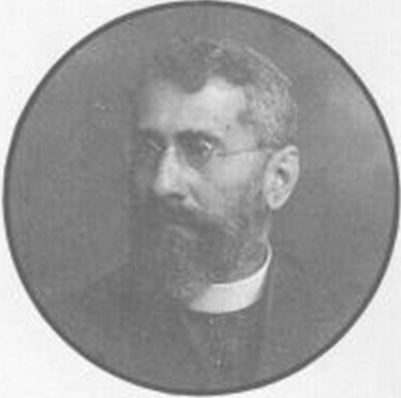
East- Aramean Chaldean
Yakob Avgin Manna |
22.
يعقوب أوجين
(=يوجين) منّا (1867-1928) ولد في
بيت قوبة
Qopa (العراق)
وكان مطرانا (أسقفا) للبصرة (العراق) وكتب العديد من الكتب
(على سبيل المثال : في عام 1901 كتب في الموصل كتاب "قطعة مختارة من
الأدب الآرامي) وقاموس سرياني – عربي. في كتابه "الحدائق الجميلة"
([22]) يقول
: "كل السريان الشرقيين والغربيين، سُمِّيوا آراميين؛
أي أبناء آرام". |
|
22.1
In his dictionary Aramaic-Arabic he writes [22.1] : |
22.1
في
قاموسه الآرامي- العربي يقول [22.1]: |
|
22.1.1.
"What induced us to dedicate to the mentioned topic a special
chapter is to end the controversy
between many Chaldeans and Syrians. Everyone of them
claims the origin for himself and to be the older one, without
having a reliable evidence or a funded scientific proof. In order to
clarify the actualness of this problem and avoid the controversy, we
say: All tribes, which lived in ancient
times in the expanded countries, which were limited in the
east by Persia, in the west by the Mediterranean, in the north by
Asia Minor, by the countries of the Armenians and Greeks and in the
south by the Arab peninsula, were known
as children of Arams or as Arameans.."
|
22.1.1.
إنّ ما حَمَلنا إلى إفراد فصل خصوصي للمواد المذكورة حُسِم النزاع
الواقع فيها بين كثير من الكلدان
والسريان. لكون كل منهما يَدَّعي الأصالة والقدميّة دون استناد
على دليل راهن أو برهان علمي مكين. فبيانا لحقيقة الأمر ومنعا
للمشاجرات نقول أنّ جميع القبائل الساكنة
قديما في البلاد الفسيحة الواسعة المحدودة ببلاد الفرس شرقا والبحر
المتوسط غربا وبلاد الأرمن وبلاد اليونان في آسيا الصغرى شمالا وحدود
جزيرة العرب جنوبا كانت قاطبة معروفة ببني
آرام أو الآراميين. |
|
22.1.2.
The countries of Babylon and Assur were at all times, even after the
Arab conquest, called Beth Aramaye, that is countries of the
Arameans. It is not necessary to demonstrate the innumerable
testimonies in order to prove this fact; it is a truth, which is
known for everybody, who has the slightest idea of the informations
about the Church of the East, because the books of our ancestors are
full of them. Likewise the countries of Mesopotamia were
well-known as the countries of Arams.
|
22.1.2.
نعم أنّ بعضا من هذه القبائل كانت تسمى أيضا بأسماء خصوصية كتسمية أهل
بابل وما يجاورها بالكلدانيين وتسمية سكان مملكة آثور بالآثوريين
وتسمية أهل الشام بالآدوميين لكن مع ذلك كانت تسمية الآراميين تشملهم
جميعا. ولا حاجة إلى إيراد الشواهد غير المحصاة لإثبات ذلك وهي حقيقة
يَقر بها مذعناً من كان له أدنى إلمام بأخبار الكنيسة الشرقية لأنّ
كتب أجدادنا مشحونة من ذكر ذلك. وكذا بلاد ما بين النهرين عُرفت دائما
ببلاد آرام |
|
22.1.3.
You will realize from the mentioned testimonies here and also
from others, that the inhabitants of Edessa and Jazira all of
them were Arameans by nation and language. Regarding the
dwellers of Syria, it is even more evident. |
22.1.3.
"فترى من الشواهد الموردة وغيرها أنّ أهل
الرها والجزيرة بأسرها كانوا آراميين
مِلّة ولغة. وأمّا
سكان الشام (السورية) فالأمر أوضح من أن يبان" |
|
22.1.4.
You will receive testimonies of the church authors, who confirm
this position. It became clear that all countries, which are known
today under the designation Syrian is, whether in the east or in the
west, were since time immemorial known as Aramean, and
this is the correct designation.
|
22.1.4.
"وستأتيك شهادات المؤلفين الكنسيّين إثباتا لذلك. فقد إتّضح إذاً أنّ
جميع البلاد المعروفة اليوم بالسريانية
سواء كانت شرقية أم غربية كانت معروفة في
قديم الزمان بالآرامية، هذه كانت
تسميتها الحقيقية". |
|
22.1.5.
The Syrian authors whether in the East or in the West,
state that the term [Syrian] comes from
Suros. Suros was a man of Aramean
origin, who founded
according to their opinion the city of Antiochia and conquered the
countries of Syria and Mesopotamia. Following him these countries
were called Syria and their inhabitants Syrians, as today the
inhabitants of the Ottoman Empire are called Ottomans.
|
22.1.5.
أمّا المؤلفون السريانيّون من الشرقيّين والغربيّين
فيزعمون أنّ لفظة سوريا متآتية من سوروس
وهو رجل من الجنس الآرامي،
بنى على زعمهم مدينة أنطاكية واستولى على بلاد سوريا وما بين النهرين،
ومنه سميت هذه البلاد سوريا، وأهلها سريانيين، كما يسمى اليوم جميع
سكان المملكة العثمانية عثمانيين" |
|
22.1.6. "The
Syrians generally, whether from the East or
from the West were not called Syrians in former times,
but
Arameans in dependance on their progenitor Aram, the son of Shem,
the son of Noah. The name 'Syrian' dates from a time about 400 or
500 B.C." |
22.1.6. أولاً:
إنّ السريان عموماً شرقيّين كانوا أم غربيّين لم يكونوا في قديم الزمان
يسمون سرياناً بل آراميّين نسبة إلى
جدّهم آرام بن سام بن نوح. ثانياّ: إنّ اسم السريان لا
يمكن أن يرتقي عهده عندهم إلى أكثر من أربعمائة أو خمسمائة سنة قبل
التاريخ المسيحي. |
|
22.1.7.
"The term Syrian
was adopted by the East-Arameans (Chaldeans and Assyrians)
after Christ through the apostles, who had proselytized these
countries." |
22.1.7.
ثالثا: إنّ اسم السريان لم يدخل على
الآراميين الشرقيين (أي الكلدان
والآثوريين) إلا بعد المسيح على يد الرسل الذين تلمذوا
هذه الديار. |
|
22.2
Hanna Aydin quotes Manna and says [14.2]: |
22.2
مطران حنّا أيدين يضع
علامة اقتباس على قاموس منّة (ينقل منه) ويقول [14.2]: |
|
22.2.1.
The refreshed meadow of the literature
of the Arameans. |
22.2.1.
المرج المتجدد من
أدب الآراميين |
|
22.2.2.
The guide of the Aramean
Chaldean language. |
22.2.2.
دليل اللغة الآرامية الكلدانية |
|
22.2.3.
The rite of the Mysterium of the holy baptism according to the
extirpation/use of the holy church of the
East- Syrians
Chaldeans |
22.2.3.
طقس
سر العماد المقدس ،
وفقا لاستخدام
الكنيسة الشرقية السريانية الكلدانية المقدسة
|
|
22.2.4.
Lectionary of the special days of the whole year according to the
extirpation/use of the holy church of the
East- Syrians
Chaldeans |
22.2.4.
كتاب الليتوريجية للأيام الخاصة للعام كله وفقا لاستخدام الكنيسة
المقدسة السريانية الكلدانية الشرقية |
|
23. Bishop Israel Audo, born 6 Aug 1859 in
Alqosh [Iraq] and passed away on 16 Feb 1941, was the brother of
Touma Audo. He was appointed as bishop of Mardin in 1909.
He wrote a book about the Genocide on the Arameans called "The
Book on the persecutions of the christian Armeniens and Arameans
of Mardin, Diyarbakir, Séert, Djézireh-Ibn-Omar and Nsibin which
took place in the year 1915" [23] |
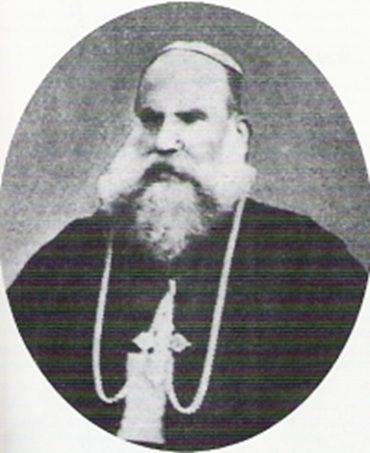
East- Aramean Chaldean Israel Audo |
23.
مطران إسرائيل عودو ولد في السادس من آب 1859 في ألقوش (العراق)
وتوفي في السادس عشر من شباط 1941، كان شقيق توما عودو. رُسِم مطرانا
لماردين في عام 1909.
وكتب كتابا عن الإبادة الجماعية للآراميين الذي يسمى
"كتاب إضطهاد المسيحيين الأرمن والآراميين في
ماردين ، ديار بكر، سعرت، جزيرة-ابن عمر ونصيبين
التي جرت في العام 1915"
[23]. |
Footnotes
[1] Syriac Manuscripts from the Vatican Library; Volume
1, VatSyr. 161, number 3. Martyrdom of St. Simeon (Symeon bar Sabba‘e),
Bishop of Seleucia and Ctesiphon, and his companions. Fol. 20a. p.40, 46, 48
[2] The Chronicle of Arbela, translated by Peter KAWERAU,
english translation by Timothy KRÓLL LOVANII IN ÆDIBUS E. PEETERS 1985 p.26
[3] F. Nau : Notes d’astronomie syrienne.
Journal Asiatique. Série 10, 1910, p. 10
[4] Th. Nöldeke: Die von Guidi
herausgegebene syrische Chronik, Wien 1893, p. 10
[5] Reinink G.J.: Gannat Bussame, I. Die Adventssonntage,
Louvain 1988, p. 33
[6] Patrologia Orientalis, Tome VII. - Fascicule 2,
Histoire Nestorienne (Chronique de Séert), Seconde Partie (1), publiée et
traduite par Mgr Addai Scher, Paris 1911, Published Paris : Firmin-Didot
1950
[6.6] Patrologia Orientalis, Tome XIII - Fascicule 4 - N°
65, Histoire Nestorienne (Chronique de Séert), Deuxième Partie (II), texte
arabe publié par S.G. Mgr Addai Scher avec le concours de Robert Griveau,
Paris 1919, Published Brepols 1983, p. 453)
[7] Hanna Aydin, Die Syrisch- Orthodoxe Kirche von
Antiochien, Ein geschichtlicher Uberblick” Bar Hebrraus Verlag Glane- Losser
1990, p.33-35.
[8] Paulus Assemani: Lumaa Tarikhiya fi Fara'id al-Adab
al-Suryaniya [= a short history of Syriac literature], Jerusalem 1933, p. 9
[9] Patriarch A. Barsaum, The Syrian Orthodox Church of
Antioch: Its Name and History, published by the syriac organizations in
Middle Europe and Sweden 1983, p. 29
[10] Commentaire d'Isodad de Merv sur l'Ancien
Testament/1, transl. Ceslas van den Eynde, Louvain 1955, p. 90
[11] E.A. Wallis Budge, The book of governors: The
Historia Monastica of Thomas, Bishop of Marga, A.D. 840 Vol. II, London 1893
[12] R. Payne Smith, Thesaurus syriacus, Oxford
1879-1901, Volume 1, columne 388
[13] His book "The light of the world", printed in
Louvian, Belgium in 1950, page 16
[14] R. Duval (ed.), Lexicon Syriacum, Paris, 1888-1901,
under "Suryoyo"
[15] see [4]
[15.1] Chronographie de Mar Élie Bar Šinaya,
Métropolitain de Nisibe, par L.-J. Delaporte Pubblicazione: Paris : H.
Champion, 1910, p. 44
[16] Das Buch von der Erkenntnis der Wahrheit, oder, Der
Ursache aller Ursachen : nach den syrischen Handschriften zu Berlin, Rom,
Paris und Oxford. (Leipzig : J.C. Hinrichs, 1889),
p. 198
[17] The Book of the Bee, edited and translated by
Earnest A. Wallis Budge, M. A. [Oxford, the Clarendon Press] 1886, chapt.
XXIII, p. 38, 99
[18] see [4]
[19] Treasure of the Syriac Language by Thomas Audo
Metropolitan of Urmia, Part I-II. ND Verlag Bar Hebräus, Losser-Holland
1985, preface
[20] see [4]
[21] Sa Grandeur Mgr. Addai Scher, De La Chaldee Et De
L’assyrie Vol. 2, (Imprimerie Catholique, Beyrouht, 1913), 5
[21.1] Quoted by bishop Julius Cicek in his introduction
of Suleyman Hinno's "Gunhe d-Suryoye d-Tur Abdin", Bar Hebräus-Verlag, 1987
[22] Asmar Al-Khoury: History of the Syriac people in
Beth Nahrin, part I, Sweden 1988
[22.1] Bishop J.E. Manna, Chaldean-Arabic Dictionary,
Babel Center Publications. Beirut 1915, p. 11-21
[22.2] see [4]
[23] Jacques Rhétoré, Les Chrétiens aux bêtes Préface par J-P Péroncel-Hugoz
Etude et présentation par Joseph Alichoran, Les Editions du Cerf, Paris,
2005
****************************************************************
Arameans of Syria:
http://www.aramnahrin.org/English/Arameans_Of_Syria.htm
Arameans of Iraq:
http://www.aramnahrin.org/English/iraqichristians.htm
 Subscribe
to our newsletter. Subscribe
to our newsletter.
Copyright © Aram-Nahrin
Organisation

|
Letters to governments and international institutions
Arabic Translations:
الترجمات
العربية
Aramean Spiritual/ Physical Genocide
Fake News on the Aramean nation:
Arameans
in the Media
How "Assyrian" fanaticism resulted in terrorism.
Who made the East- Aramean Nestorians known as "Assyrians"?
Question:
Who were the ancient Assyrians? Were they simply one ethnicity or a
composition of many nations/ tribes?
6-9-2014:
Why are modern “Assyrians” very important to the illuminati Satanists?
21-2-2014:
The origin of “Assyrian” fanaticism, their blindness, veneration of occult
powers
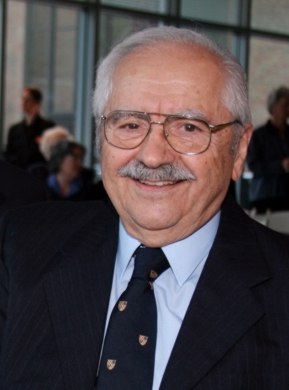
Professor Dr.
John Joseph.
5-7-2008:
Assyria and Syria: Synonyms?
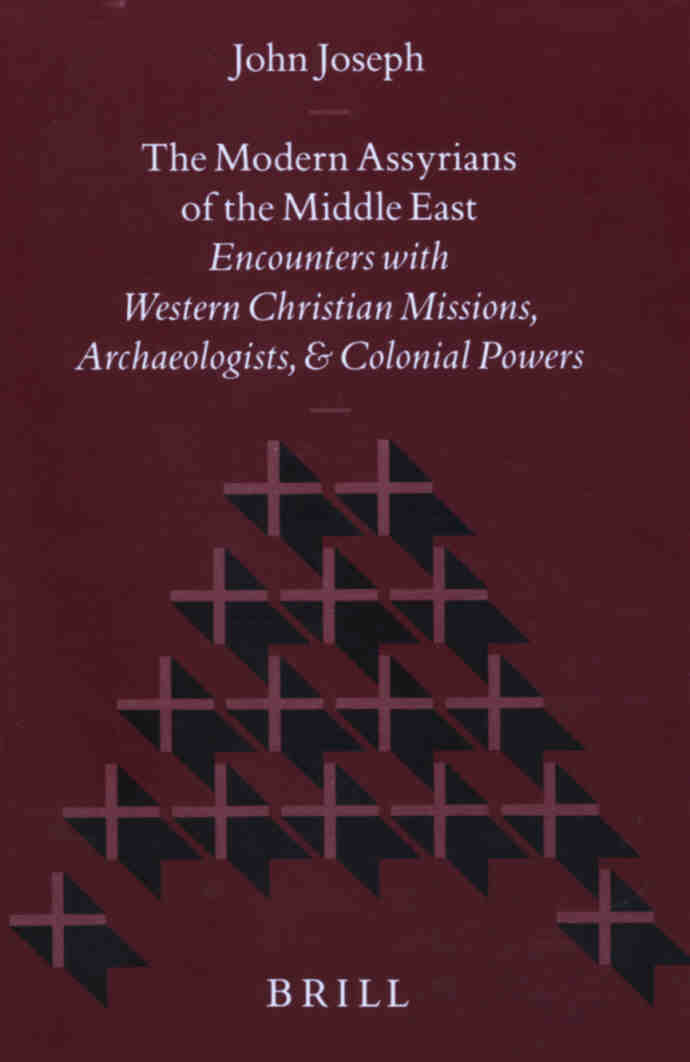
In a letter to the author (John Joseph), dated June 11,
1997, Patricia Crone wrote that she and Cook
“do not argue that the Nestorians of pre-Islamic Iraq saw themselves as
Assyrians or that this is what they called
themselves. They called themselves Suryane, which had no greater
connotation of Assyrian in their usage than it did in anyone else….
We take it for granted that they
got the modern Assyrian label from the West
and proceeded to reinvent themselves…
Of course the Nestorians were Arameans.”
(Page 27, footnote 94)
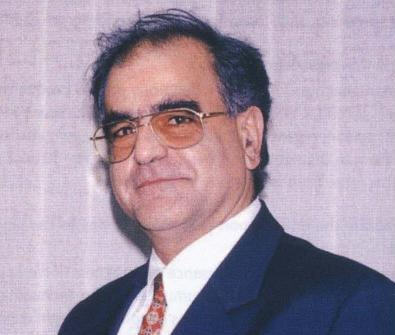
Professor Dr.
Muhammad Shamsaddin Megalommatis
28-6-2004:
Progenitor of Wars and Tyrannies: the Falsehood of Pan-Arabism
 The
deep and hidden reason of the tyrannical oppression practiced throughout the
Middle East is the imposition by France and England of pan-Arabic
nationalist cliques that intend to dictatorially arabize the various peoples
of the Middle East, who are – all – not Arabs The
deep and hidden reason of the tyrannical oppression practiced throughout the
Middle East is the imposition by France and England of pan-Arabic
nationalist cliques that intend to dictatorially arabize the various peoples
of the Middle East, who are – all – not Arabs
10-8-2005:
The Aramaeans'
rise will transfigure the Middle Eastern Chessboard
 The
basic fact is that all these populations are only Arabic – speaking; they
are not Arabs. Their ethnic historical identity
is Aramaic. Aramaeans are Semitic, but as distant from the
Arabs as the Ancient Hebrews were from the Babylonians. For reasons we are
going to explain, these Aramaean populations got
gradually arabized, but the arabization phenomenon took place
at the linguistic level only, not at the ethnic,
national, cultural levels The
basic fact is that all these populations are only Arabic – speaking; they
are not Arabs. Their ethnic historical identity
is Aramaic. Aramaeans are Semitic, but as distant from the
Arabs as the Ancient Hebrews were from the Babylonians. For reasons we are
going to explain, these Aramaean populations got
gradually arabized, but the arabization phenomenon took place
at the linguistic level only, not at the ethnic,
national, cultural levels
 Out
of it, colonial missionaries, political agents, and diplomats
made a huge
lie (namely that these Aramaeans are not Aramaeans but 'Assyrians') with
which they disconnected the Nestorian Aramaeans from their Aramaic identity Out
of it, colonial missionaries, political agents, and diplomats
made a huge
lie (namely that these Aramaeans are not Aramaeans but 'Assyrians') with
which they disconnected the Nestorian Aramaeans from their Aramaic identity
18-12-2008:
Syriacs, "Assyrians" and "Chaldaeans" are all Aramaeans
 What
is the correct national name of the Modern Aramaeans?
Why are there Aramaeans, who despite the fact that they speak Aramaic, insist on calling
themselves 'Assyrians'?
Why other Aramaeans stick to a third name, 'Chaldaeans'?
Is it proper to use the name 'Syriac' that usually describes a late form of
Aramaic language and scripture (from which Arabic derived) as national name
of the Aramaeans? What
is the correct national name of the Modern Aramaeans?
Why are there Aramaeans, who despite the fact that they speak Aramaic, insist on calling
themselves 'Assyrians'?
Why other Aramaeans stick to a third name, 'Chaldaeans'?
Is it proper to use the name 'Syriac' that usually describes a late form of
Aramaic language and scripture (from which Arabic derived) as national name
of the Aramaeans?
16-12-2008:
Pseudo-Assyrians, Pseudo-Chaldaeans, and the Cultural – National Needs of
the Aramaean Nation
 Contrarily
to the farfetched – and well financed – inaccuracies of Simo Parpola, there
is not a single element in the defunct before 2600 years Assyrian Cultural
and National Heritage to resemble in anything with the genuinely Aramaean
culture of today’s Aramaeans, irrespective of the appellation that they use
to designate themselves, Aramaeans, Chaldaeans, Assyrians or
Zulu............. Contrarily
to the farfetched – and well financed – inaccuracies of Simo Parpola, there
is not a single element in the defunct before 2600 years Assyrian Cultural
and National Heritage to resemble in anything with the genuinely Aramaean
culture of today’s Aramaeans, irrespective of the appellation that they use
to designate themselves, Aramaeans, Chaldaeans, Assyrians or
Zulu.............
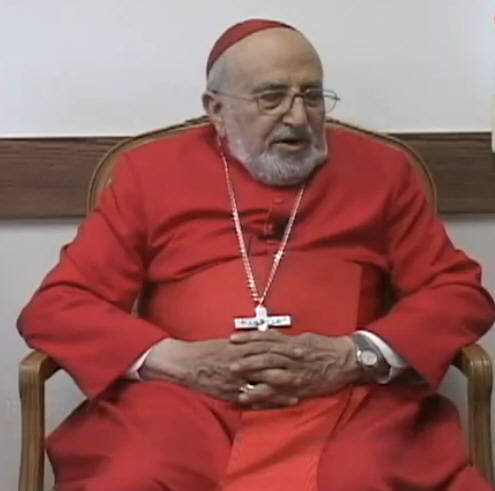
Patriarch
Emmanuel III Delly
28-10-2008:
“...but
I would like to state that we, the Chaldean, Assyrian and Syrian people are
one people called Aramean”
13-5-2006:
Is there an Assyrian cause in Iraqi Kurdistan?
 But
this claim has been researched by historians, and concluded that people in
middle East mostly refer to people to their region, like someone from
Kirkuk, was named Kirkuki whether he was , Kurd, Turkmen or Aramean. So is
the case with Assyrians or actually the “Athuris” that is how they are
called in the region. That name is been used to
label the Nestorian Arameans of Athur(Asur) region at the suburbs of Mosul.
The term has
no
any relation with the ancient Assyrians and the modern Assyrians But
this claim has been researched by historians, and concluded that people in
middle East mostly refer to people to their region, like someone from
Kirkuk, was named Kirkuki whether he was , Kurd, Turkmen or Aramean. So is
the case with Assyrians or actually the “Athuris” that is how they are
called in the region. That name is been used to
label the Nestorian Arameans of Athur(Asur) region at the suburbs of Mosul.
The term has
no
any relation with the ancient Assyrians and the modern Assyrians
2-8-2005:
IRAQ's Modern History.
The Arab Majority and The
Minorities
 As
for the terms "Assyrians"
and "Chaldaeans,"
which are used to describe non-Arab Christians (other than Armenians),
there
is absolutely no historical reference of their association with the
Assyrians and Chaldaeans of ancient Mesopotamia As
for the terms "Assyrians"
and "Chaldaeans,"
which are used to describe non-Arab Christians (other than Armenians),
there
is absolutely no historical reference of their association with the
Assyrians and Chaldaeans of ancient Mesopotamia
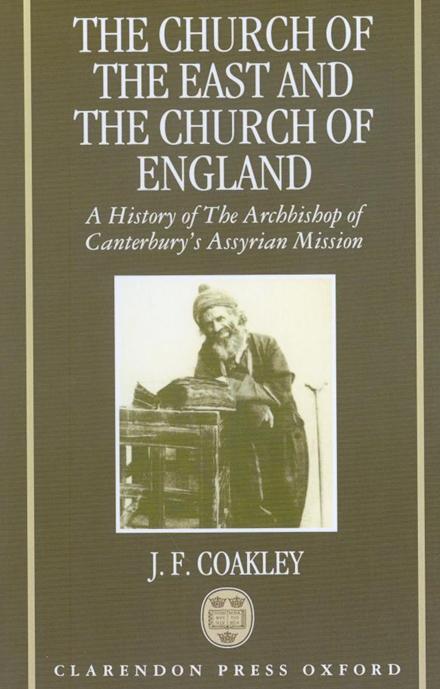
“The Church of the East and the
Church of England: A History of the Archbishop of Canterbury's Assyrian
Mission “ is the title of the book written by J.F. Coakley and
published in 1992.
On page 147 Coackly reports about a dispute between Arthur Maclean,
head of the Archbishop of Canterbury's Assyrian Mission from 1886 to 1891,
and Hormuzed Rassam, the brother of Christian Antun (Isa) Rassam; a Chaldean
family from Mosul. We read:
“As he (Maclean) insisted, the ‘Syrians’ called
themselves that, never ‘Assyrians’; …… to apply the name
‘Assyrians’ to these Eastern Syrian Christians
appears to me either an error, or else pedantry. There is really
as far as I know no proof that they had any
connection with the Old Assyrians. ....... ..... Why should
we invent a name when we have
such a very convenient one, used for centuries, at
our hand? I can understand that one living close to the ruins of
Nineve should have a fit enthusiasm of Old Assyria;
but is it common sense to cast aside a name
used by the people themselves, and to
invent another for them of very doubtful applicability?
“
|




























